By: CS2103T-F10-2 Since: Feb 2020 Licence: MIT
- 1. Introduction
- 2. Setting Up
- 3. Design
- 4. Implementation
- 4.1. Sort Command
- 4.2. Clear Command
- 4.3. Command History
- 4.4. Interview and Interview Commands
- 4.5. Find Command
- 4.6. Archival System
- 4.7. Statistics Feature
- 4.8. Reminder Command
- 4.9. Logging
- 4.10. Configuration
- 5. Documentation
- 6. Testing
- 7. Dev Ops
- Appendix A: Product Scope
- Appendix B: User Stories
- Appendix C: Use Cases
- Appendix D: Non Functional Requirements
- Appendix E: Glossary
- Appendix F: Product Survey
- Appendix G: Instructions for Manual Testing
- G.1. Launch and Shutdown
- G.2. Using Internship Diary with Sample Internship Application List
- G.3. Command Box
- G.4. Main List View
- G.5. Archival List View
- G.6. Adding an Internship Application
- G.7. Deleting Internship Application
- G.8. Archiving Internship Application
- G.9. Unarchiving Internship Application
- G.10. Adding an Interview to an Internship Application
- G.11. Editing an Interview in an Internship Application
- G.12. Showing Statistics Window
- G.13. Sorting the List of Internship Applications
- G.14. Getting Reminders for Internship Applications
- G.15. Finding Internship Applications
- G.16. Saving Data
- Appendix H: Effort
1. Introduction
This developer guide is written for software developers or designers who wish to contribute to the project. However, you may also use it if you wish to gain deeper insight into the system design and implementation of Internship Diary.
2. Setting Up
Refer to the guide here.
3. Design
3.1. Architecture

The Architecture Diagram given above explains the high-level design of the App. Given below is a quick overview of each component.
-
At app launch: Initializes the components in the correct sequence, and connects them up with each other.
-
At shut down: Shuts down the components and invokes cleanup method where necessary.
Commons represents a collection of classes used by multiple other components.
The following class plays an important role at the architecture level:
-
LogsCenter: Used by many classes to write log messages to the App’s log file.
The rest of the App consists of four components.
Each of the four components
-
Defines its API in an
interfacewith the same name as the Component. -
Exposes its functionality using a
{Component Name}Managerclass.
For example, the Logic component (refer to Logic Class Diagram) defines it’s API in the Logic.java interface and exposes its functionality using the LogicManager.java class.
How the architecture components interact with each other
The Sequence Diagram below shows how the components interact with each other for the scenario where the user issues the command delete 1.

delete 1 commandThe sections below give more details of each component.
3.2. UI Component

API : Ui.java
The UI consists of a MainWindow that is made up of parts e.g.CommandBox, ResultDisplay, InternshipApplicationListPanel, StatusBarFooter etc.
All these, including the MainWindow, inherit from the abstract UiPart class.
The UI component uses JavaFx UI framework.
The layout of these UI parts are defined in matching .fxml files that are in the src/main/resources/view folder.
For example, the layout of the MainWindow is specified in MainWindow.fxml
The UI component,
-
Executes user commands using the
Logiccomponent. -
Listens for changes to
Modeldata so that the UI can be updated with the modified data.
3.3. Logic Component

API :
Logic.java
-
Logicuses theInternshipDiaryParserclass to parse the user command. -
This results in a
Commandobject which is executed by theLogicManager. -
The command execution can affect the
Model(e.g. adding an internship application). -
The result of the command execution is encapsulated as a
CommandResultobject which is passed back to theUi. -
In addition, the
CommandResultobject can also instruct theUito perform certain actions, such as displaying help to the user.
Given below is the Sequence Diagram for interactions within the Logic component for the execute("select 1") API call.
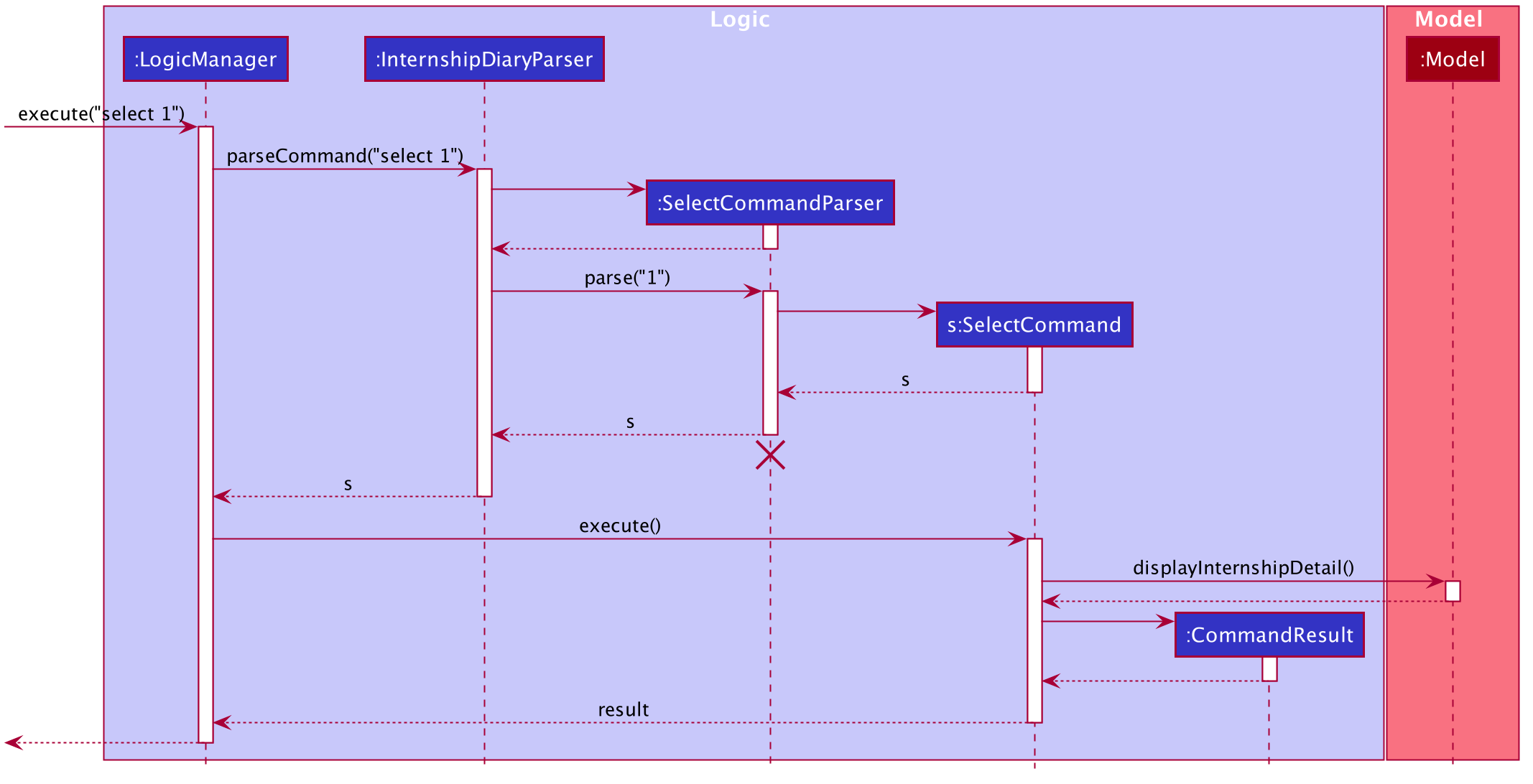
select 1 Command
The lifeline for SelectCommandParser should end at the destroy marker (X) but due to a limitation of PlantUML, the lifeline reaches the end of diagram.
|
3.4. Model Component

API : Model.java
The Model,
-
stores a
UserPrefobject that represents the user’s preferences. -
stores the Internship Diary data.
-
exposes an unmodifiable
ObservableList<InternshipApplication>that can be 'observed' e.g. the UI can be bound to this list so that the UI automatically updates when the data in the list change. -
does not depend on any of the other three components.
3.5. Storage Component

API : Storage.java
The Storage component,
-
can save
UserPrefobjects in JSON format and read it back. -
can save the
InternshipDiarydata in JSON format and read it back.
3.6. Common Classes
Classes used by multiple components are in the seedu.diary.commons package.
4. Implementation
This section describes some noteworthy details on how certain features are implemented.
4.1. Sort Command
The sort command allows the user to sort the currently visible list of internship applications. The following sequence diagram will illustrate the process of invocation for the command:
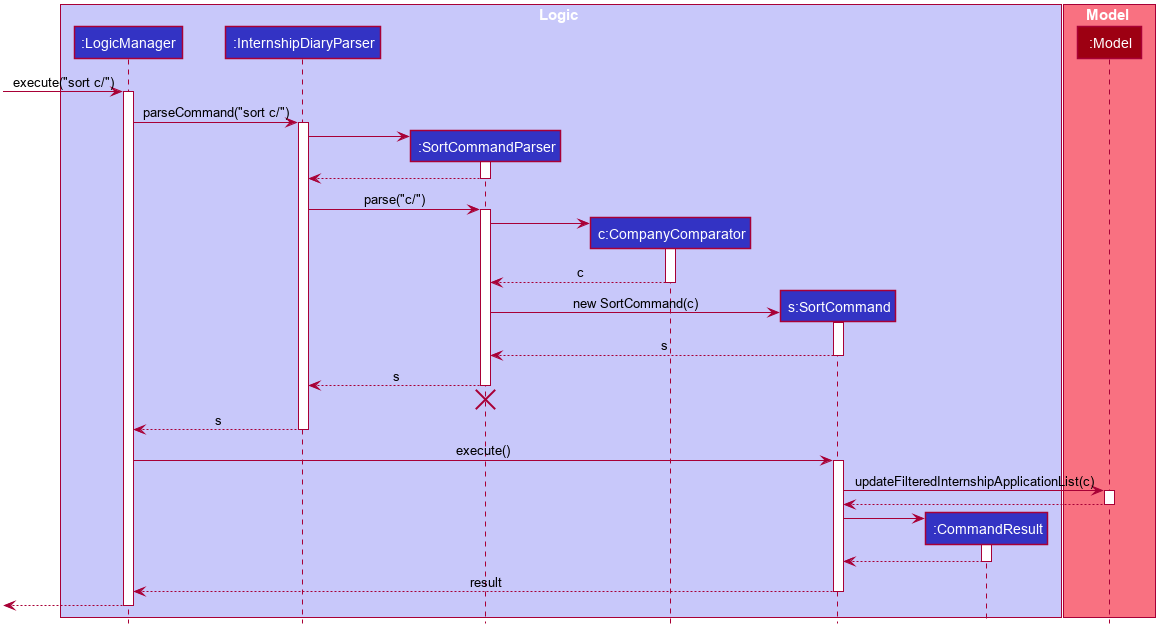
Logic Component for the sort c/ commandThe following subsections will go through the general implementations of the sort command.
4.1.1. Implementation
The sort command is implemented in the class SortCommand and uses the SortCommandParser class to parse the arguments for the command.
To facilitate the sort command, several comparator classes implementing Comparator<InternshipApplication> are used:
-
ApplicationDateComparator— Comparator to compare internship applications by theirApplicationDatefield in chronological order. -
CompanyComparator— Comparator to compare internship applications by theirCompanyfield in lexicographical order. -
PriorityComparator— Comparator to compare internship applications by theirPriorityfield in ascending order. -
RoleComparator— Comparator to compare internship applications by theirRolefield in lexicographical order. -
StatusComparator— Comparator to compare internship applications by theirStatusfield by the order which they are declared in the Status Enum class.
The SortCommandParser stores all of these Comparators in an immutable static Map mapping a prefix to each Comparator object.
As the Comparators are all immutable, we can treat the Map as completely immutable.
The SortCommandParser looks for a acceptable prefix in the command, and passes the corresponding comparator to SortCommand.
If the number of such prefixes found is not exactly one, SortCommandParser throws a ParseException.
The toString() method of all Comparators have also been overridden with a description of the comparator, so as
to allow the DisplayComparatorFooter to retrieve information of the current Comparator without passing a separate String
to it.
Reverse Sort
This version of the command is invoked when the user enters the command with reverse as the preamble text in the parameter, e.g. sort reverse c/.
After retrieving the correct comparator to use, the parser would pass comparator.reversed() to the constructor of SortCommand instead of comparator.
This would reverse the order in which the currently visible list of internship applications is sorted in.
The reversed() method of the Comparators used have actually been overridden to return ReversedComparator, so as to override
the toString() method of the newly created Comparator for the DisplayComparatorFooter.
The following class diagram will illustrate the overall structure of SortCommand:
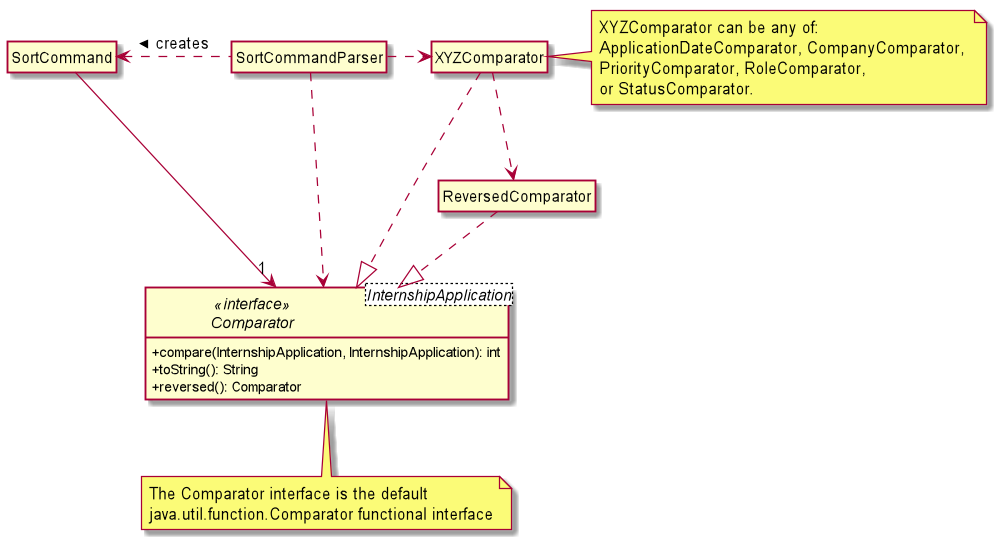
SortCommand4.1.2. Design Considerations
4.1.2.1. Aspect: How to sort by multiple fields
-
Alternative 1 (current choice): Accept only one field to sort by when using
SortCommand. This works as the list uses stable sort.-
Pros: More streamlined, less complex.
EnteredCommandsHistoryallows the user to get the sort command template back in just one press of the up arrow key so there is little hassle.
Users do not have to remember the order to place the arguments to get the sort they want. -
Cons: Hard to explain the concept of stable sort in the User Guide, if a more in depth explanation were to be given.
-
-
Alternative 2: Allow multiple fields to sort by.
-
Pros: Two less key presses.
-
Cons: Code becomes much more complex.
Users has to remember the order to place the arguments to get the sort they want.
Users are highly unlikely to use this feature, as sorting one field by one feels more natural.
Harder to implement reverse sorting.
-
4.2. Clear Command
The clear command allows the user to delete all internship applications. The following sequence diagram will illustrate the process of invocation for the command:
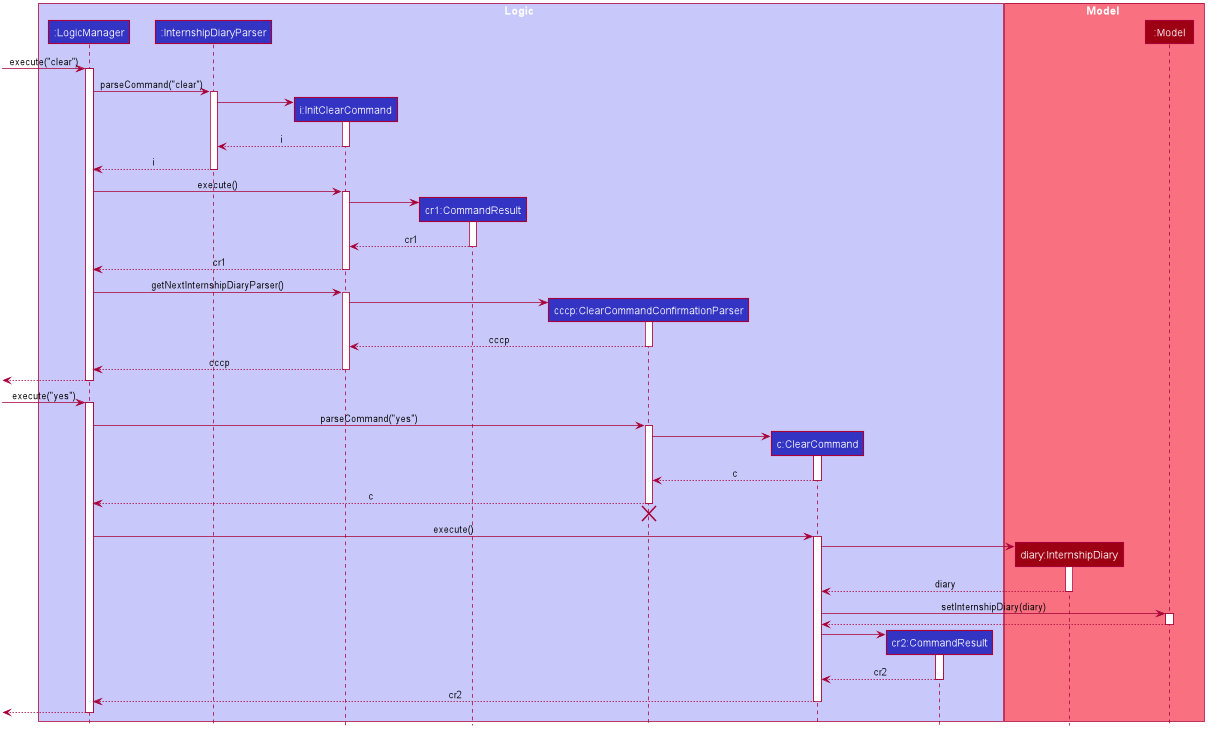
Logic Component for ClearCommand.The following subsections will go through the general implementations of the clear command.
4.2.1. Implementation
The find command is implemented in the class InitClearCommand, ClearCommand and uses the
ClearCommandConfirmationParser class to parse the arguments for the command.
The implementation for this command is unique as it causes 'LogicManager' to use ClearCommandConfirmationParser, which is a subclass of InternshipDiaryParser, as the main parser to parse the next user input.
4.2.2. Design Considerations
4.2.2.1. Aspect: How to prompt for confirmation
-
Alternative 1 (current choice): Implement an abstract method
getNextParserfor all commands.-
Pros: Easy to extend.
New commands which require a prompt or alternative parsing do not need to further modify theInternshipDiaryParserorLogicManagerclass. -
Cons: All commands will have to implement a
getNextParsermethod. AsgetNextParserreturnsnullfor most commands, an abstract class is used. However, this means that commands cannot extend other abstract classes in the future.
-
-
Alternative 2: Have
InternshipDiaryParserhave different modes depending on what command was last executed.-
Pros: Simple to understand.
-
Cons:
InternshipDiaryParserhas no access to the next mode the command leads into,LogicManagerneeds to pass it intoInternshipDiaryParser.
As the different modes do not share code, they are better off as separate classes.
-
-
Alternative 3: Make a confirmation window which freeze the main window.
-
Pros: The
InternshipDiaryParserorLogicManagerclass may not need to be modified. -
Cons: Relies on global static methods which may lead to bugs in the future.
-
4.3. Command History
The command history feature allows the user to press the up and down arrow keys to select previous commands.
The following activity diagram depicts the behaviour of the CommandBox while the user is entering commands.
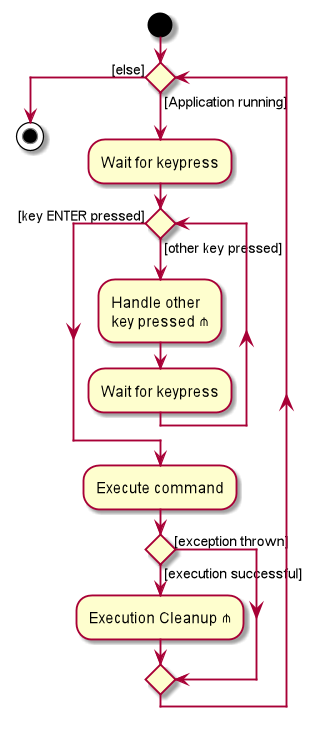
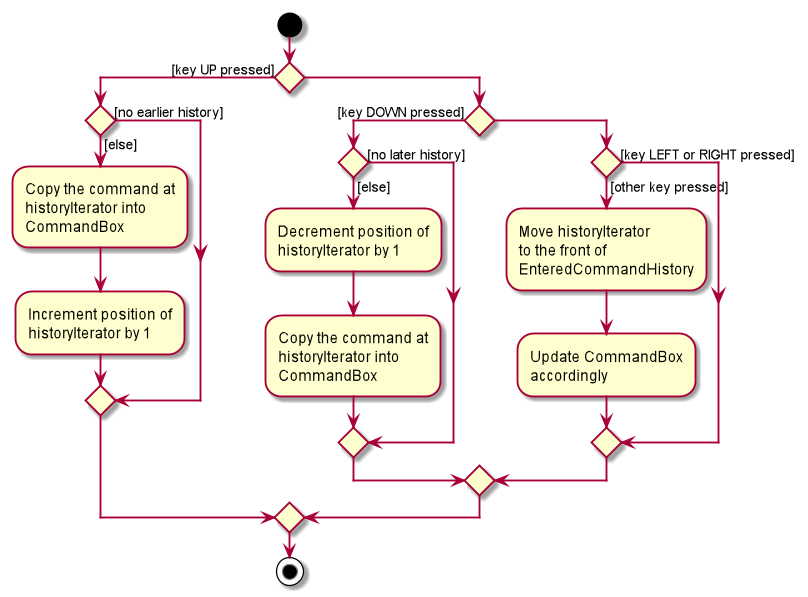
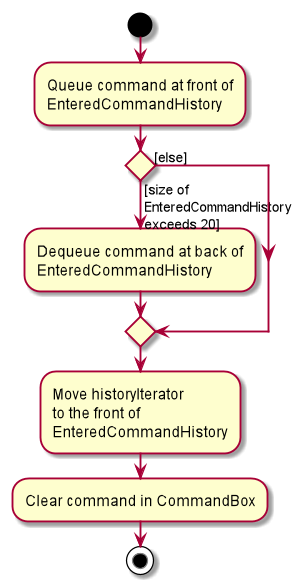
The following subsections will go through the general implementations of the command history feature.
4.3.1. Implementation
The implementation of command history involves only the UI classes CommandBox and EnteredCommandsHistory.
Internally, EnteredCommandsHistory uses a LinkedList to store the command history. The LinkedList data structure
was chosen the data structure needed to be a queue which also allows the last accessed element to be reaccessed quickly.
This meant that the data structure has to support random access or have a ListIterator. Unfortunately, Java’s default
ArrayDeque does not support either. While it is possible to implement an ArrayDeque with random access, the default
LinkedList already provides a ListIterator. While this is potentially slower than an ArrayDeque with random access,
for the sake of convenience, LinkedList was chosen.
Currently, a size limit of 20 is imposed on EnteredCommandsHistory. A limit is required as storing unlimited commands is not feasible.
Also, it is highly unlikely that users would need to see their entered commands beyond a certain point.
Although this feature is fairly simple and based off Windows Command Prompt, there were still a few design aspects worth considering.
4.3.2. Design Considerations
4.3.2.1. Aspect: What should happen when down key is pressed when the latest history is being shown
-
Alternative 1 (current choice): Blank the
CommandBox.-
Pros: Provides users a fast way to clear the
CommandBox. -
Cons: Users are unable to view their command history without losing the command they have typed.
-
-
Alternative 2: Nothing (Same as Windows Command Prompt).
-
Pros: Easy to implement.
-
Cons: Users are unable to view their command history without losing the command they have typed.
No fast way to clear theCommandBox.
-
-
Alternative 2: Store and display the last modified text.
-
Pros: Users can view their command history without losing the command they have typed.
-
Cons: No fast way to clear the
CommandBox.
Harder to implement.
-
4.3.2.2. Aspect: Should invalid commands be stored
-
Alternative 1 (current choice): No.
-
Pros: Reduces clutter in the command history.
-
Cons: Users would not be able to see their failed attempts.
Users are unable to look at their command history without losing the command they have typed (due to above decision).
-
-
Alternative 2: Yes (Same as Windows Command Prompt).
-
Pros: User can store an incomplete draft command in the command history.
-
Cons: Users who frequently make mistakes would find it troublesome to navigate through all the failed attempts. This is especially so as our application does not have an autocomplete feature.
-
4.3.2.3. Aspect: When should the position of historyIterator reset
-
Alternative 1 (current choice): Whenever user modifies the text in the
CommandBoxand when command executed successfully.-
Pros: Less confusing for users.
-
Cons: More key presses to repeat a series of commands.
-
-
Alternative 2: Never (Same as Windows Command Prompt).
-
Pros: Users can easily repeat a series of commands.
-
Cons: Potentially confusing for users. Harder to implement as underlying data structure is linked list.
-
4.3.3. [Proposed Improvements] Command History Storage
There are plans to save the command history in the hard drive, so that it may be accessed across sessions. However, due to the complexity and difficulty of implementation, it will only be rolled out in a future version.
4.4. Interview and Interview Commands
4.4.1. Implementation
The implementation of interviews will be facilitated by two overarching components, the Model Abstract Class Interview
which is associated to an InternshipApplication (see Model Diagram Section 3.4, “Model Component” ) and the Logic Classes InterviewCommandParser and InterviewCommand.
The Logic Classes will interact with the Interview Classes to modify the interviews list in InternshipApplication.
More detailed explanations will be provided in the subsequent sections.
4.4.2. Interview
There are two types of interviews currently available in Internship Diary:
-
Online Interview— this type of interview will not carry an address. A placeholderAddress"NA" will be set. -
Offline Interview— this type of interview must have an address.
Interview will consist of the following variables and method:
-
getIsOnline()— abstract method that returns whether the interview is to be conducted online. -
ApplicationDateinterviewDate — indicates the date of the interview. -
AddressinterviewAddress — indicates the address of the interview.
In particular, Interview will rely on the ApplicationDate and Address classes in the internship package to implement
interviewDate and interviewAddress
The class diagram below shows the classes associated to Interview.
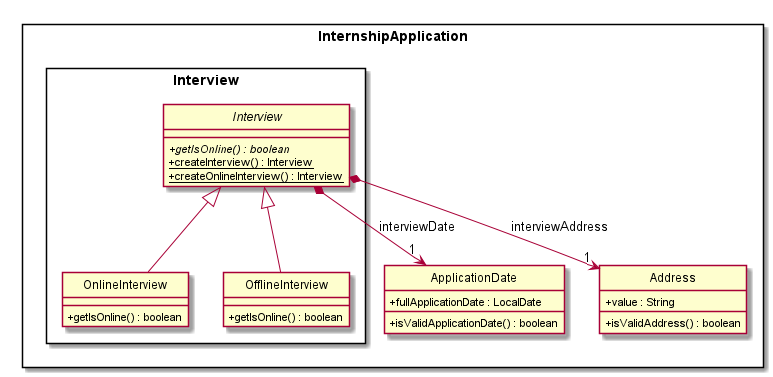
Interview and its associated classes4.4.3. Interview Commands
Interviews can only be modified through the interview command which relies upon InterviewCommandParser and InterviewCommand classes.
The interview command will encompass four types of sub-command:
-
add— add anInterviewto the specifiedInternshipApplication. -
edit— edits a specifiedInterviewthat exists in the interview list in the specifiedInternshipApplication. -
delete— deletes a specifiedInterviewthat exists in the interview list in the specifiedInternshipApplication. -
list— lists allInterviewin the specifiedInternshipApplication.
Currentlylistfunctions similarly toselect, additional functions for list will be proposed in Section 4.4.5, “[Proposed Improvements] InterviewListCommand”.
Correspondingly, the InterviewCommand class will be made abstract with specific implementation
of each sub-command in an inheriting class, this can be seen in the diagram below.
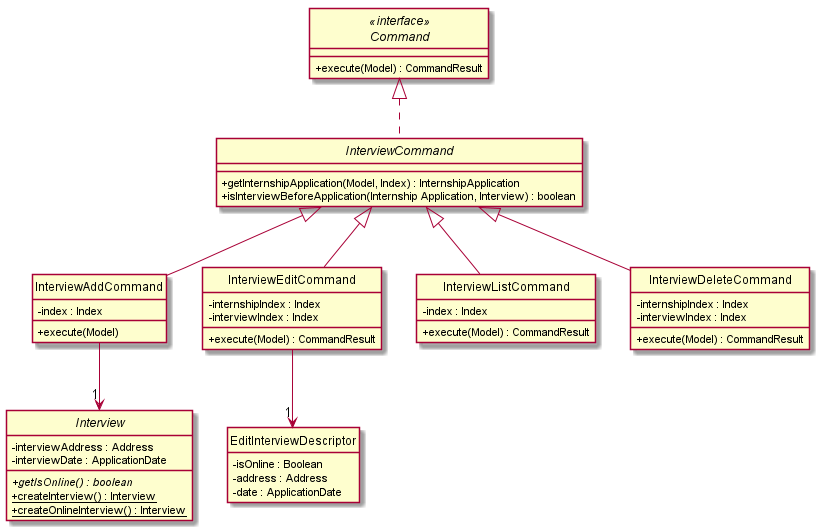
InterviewCommand class with its respective sub-commandsAdditionally, InterviewCommand will implement the following static operations to facilitate sub-commands:
-
InterviewCommand#getInternshipApplication(Model, Index)will assist all sub-commands in acquiring theInternshipApplicationto modify. -
InterviewCommand#isInterviewBeforeApplication(InternshipApplication, Interview)will assisteditandaddcommands in checking whether the interview occurs before the internship application.
Lastly, as the commands inherit from Command interface, the commands will implement execute(Model).
All the sub-commands follow roughly the same execution sequence as seen in the diagram below.
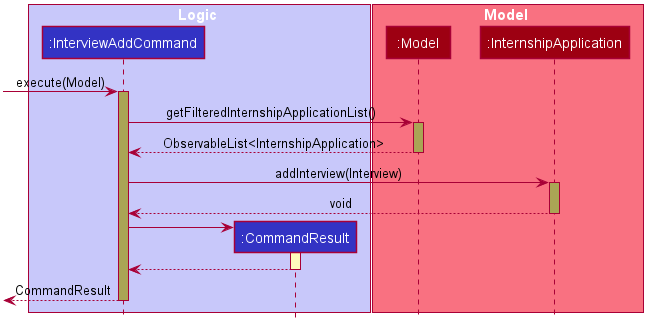
InterviewAddCommandThe execution sequence will first modify the InternshipApplication based on the specific sub-command.
Then followed by creating a CommandResult, and returning it.
4.4.4. Interview Commands Parser
InterviewCommandParser is the entry point to all interview sub-commands.
It will be called from `InternshipDiaryParser`which is the primary logic parser for user input.
InterviewCommandParser will support the parsing of all four types of InterviewCommand sub-commands.
The following activity diagram will show how InterviewCommandParser reads and interpret user input to
return the expected sub-command.
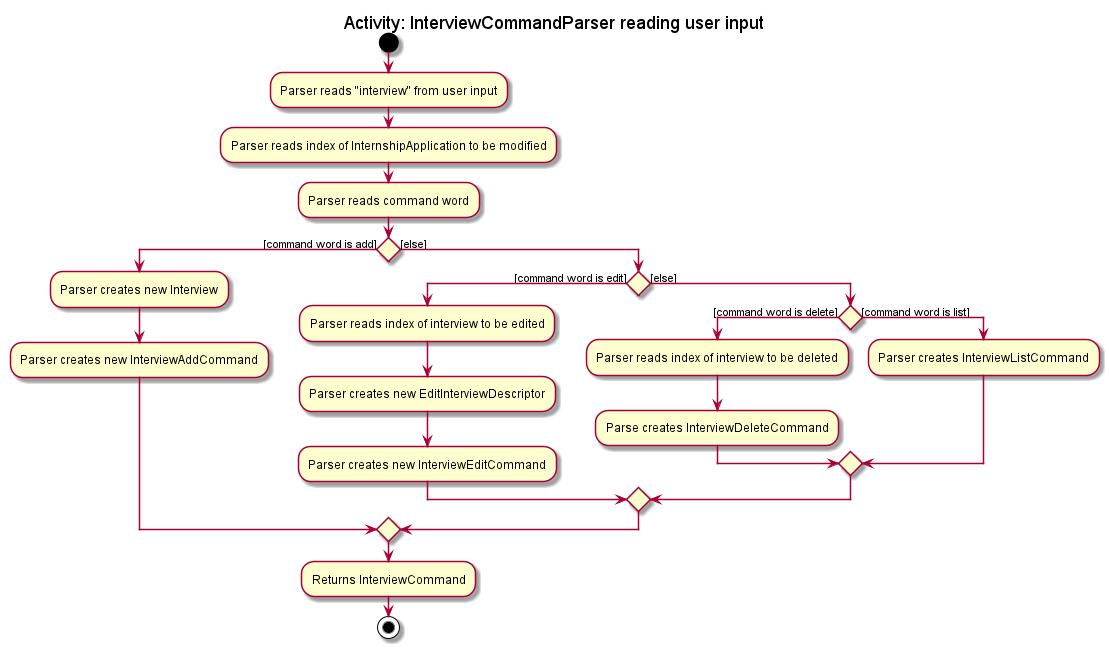
InterviewCommandParser when reading user inputAdditionally, InterviewCommandParser will only be invoked within the Logic component, with the only exception being
InterviewAddCommand.
Figure 18 will show the general invocation format within the Logic component using InterviewDeleteCommand
as an example.
While Figure 19 will show the invocation of InterviewAddCommand which is the only sub-command that will utilise the
Model component.
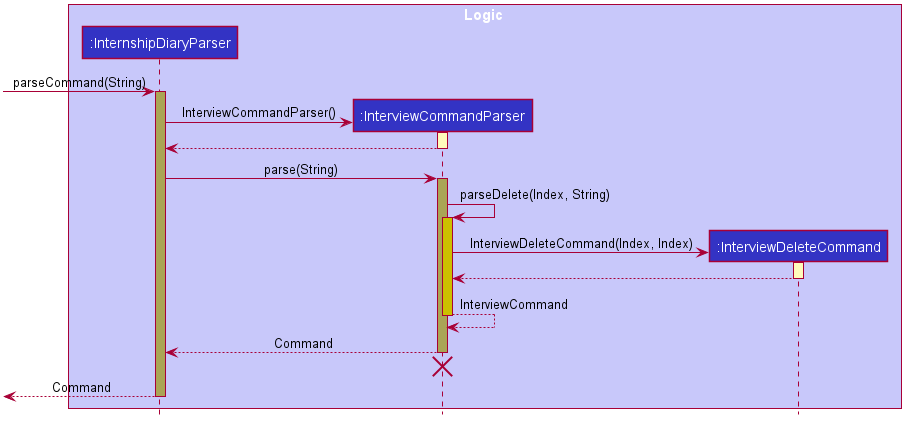
InterviewDeleteCommand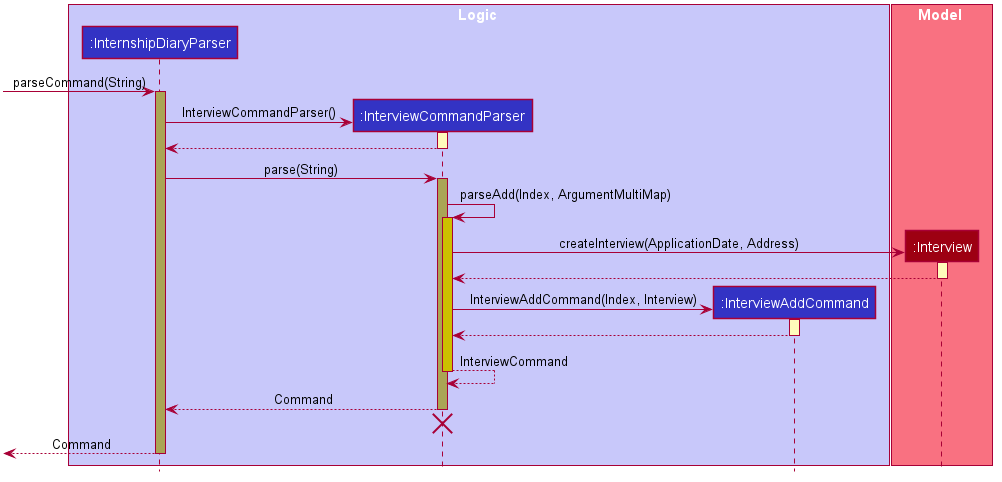
InterviewAddCommand4.4.5. [Proposed Improvements] InterviewListCommand
Currently, the InterviewListCommand is functionally similar to SelectCommand.
In v2.0, there will be the following improvements to the InterviewListCommand:
-
Additional parameters to filter interviews
-
New command format will be
interview INDEX list [o/IsOnline] [a/Address] [d/Date]. -
The command will return the list of interviews consisting of only the interviews that contain the optional fields provided in the command.
-
FilteredListfromjavafxwill be used to implement this feature.
-
4.4.6. Design Considerations
4.4.6.1. Aspect: How to implement interview
-
Alternative 1 (current choice in v1.4): Use an abstract class as the primary reference to Interviews. Implement types of Interview as extending classes.
-
Pros: More scalable, able to easily add new Interview types.
Easier to debug and handle exceptions. -
Cons: More classes to create and handle.
-
-
Alternative 2 (previous choice in v1.3): Use a concrete Interview class with additional variables to differentiate Interview types.
-
Pros: Easy to implement.
-
Cons: Increasing number of variables if more interview types will be added.
-
4.4.6.2. Aspect: How to implement different Interview Commands
-
Alternative 1 (current choice): Use a standardized command with sub-command type parsed as user input.
-
Pros: More streamlined, only one command.
Able to use polymorphism to share operations between commands. -
Cons: Harder to implement and document.
-
-
Alternative 2: Use separate commands for each different method of modifying interview.
-
Pros: Easy to implement.
-
Cons: Makes the user remember more commands.
Create a lot of repetition in code.
-
4.5. Find Command
The find command allows the user to get a filtered list of internship applications. The following sequence diagram will illustrate the process of invocation for the command:
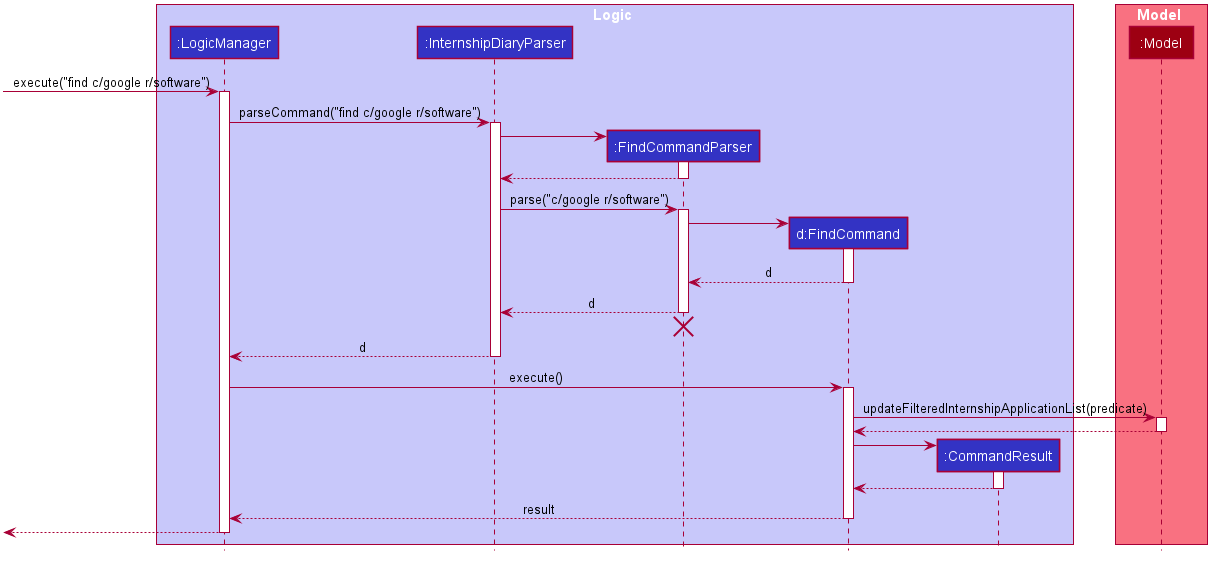
find c/google r/software commandThe following subsections will go through the general implementations of the find command, as well as the 2 versions of the command, find any match, and find match by fields.
4.5.1. Implementation
The find command is implemented in the class FindCommand and uses the FindCommandParser class to parse the arguments for the command.
To facilitate the find command, several predicates classes implementing Predicate<InternshipApplication> are used:
-
CompanyContainsKeywordsPredicate— Predicate to check if an internship application’sCompanyfield contains any substring matching any words in the list supplied by its constructorCompanyContainsKeywordsPredicate(List<String> keywords). -
RoleContainsKeywordsPredicate— Predicate to check if an internship application’sRolefield contains any substring matching any words in the list supplied by its constructorRoleContainsKeywordsPredicate(List<String> keywords). -
AddressContainsKeywordsPredicate— Predicate to check if an internship application’sAddressfield contains any substring matching any words in the list supplied by its constructorAddressContainsKeywordsPredicate(List<String> keywords). -
PhoneContainsNumbersPredicate— Predicate to check if an internship application’sPhonefield contains any substring matching any words in the list supplied by its constructorPhoneContainsNumbersPredicate(List<String> numbers). -
EmailContainsKeywordsPredicate— Predicate to check if an internship application’sEmailfield contains any substring matching any words in the list supplied by its constructorEmailContainsKeywordsPredicate(List<String> keywords). -
PriorityContainsNumbersPredicate— Predicate to check if an internship application’sPriorityfield exactly matches any words in the list supplied by its constructorPriorityContainsNumbersPredicate(List<String> numbers). -
ApplicationDateIsDatePredicate— Predicate to check if an internship application’sApplicationDatefield is exactly the date supplied by its constructorApplicationDateIsDatePredicate(List<String> dateArr). The constructor will parsedateArrinto aLocalDate. -
StatusContainsKeywordsPredicate— Predicate to check if an internship application’sStatusfield contains any substring matching any words in the list supplied by its constructorStatusContainsKeywordsPredicate(List<String> keywords).
The following class diagram show the relationship of the above mentioned predicates, Predicate, FindCommandParser and FindCommand:
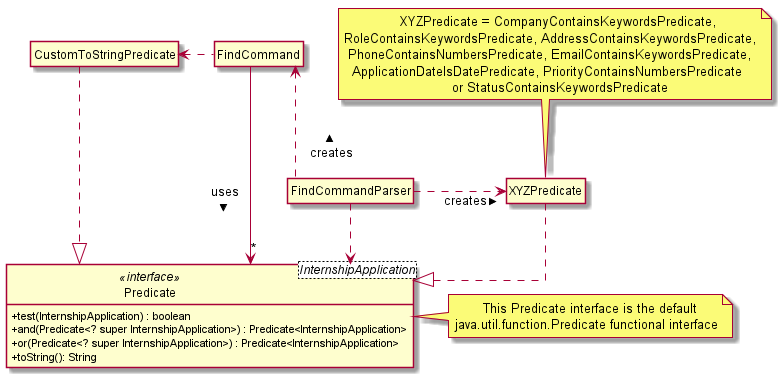
Predicates, FindCommandParser and FindCommand4.5.2. Find Any Match
This version of the command is invoked when the user enters the command with preamble text in the parameter, e.g.
find google facebook or find google r/software.
The command will perform search for any internship application where any of the fields Company, Role, Address, Phone, Email, Priority or Status contains a substring matching at least one word in the preamble and display them, e.g. find google facebook will look for internship applications whose any of the above fields contains the substring google or facebook.
The searching and displaying of the internship application is done by performing an OR operation on all the predicates
CompanyContainsKeywordsPredicate, RoleContainsKeywordsPredicate, AddressContainsKeywordsPredicate,
PhoneContainsNumbersPredicate, EmailContainsKeywordsPredicate, PriorityContainsNumbersPredicate and
StatusContainsKeywordsPredicate to get a single predicate and passing that into the method
updateFilteredInternshipApplicationList() of the ModelManager instance.
4.5.3. Find Match by Fields
This version of the command is invoked when the user enters the command without any preamble text in the parameter, e.g.
find c/google r/software.
The command will perform a search for any internship application where the fields
Company, Role, Address, Phone, Email, ApplicationDate, Priority and Status match any of the supplied word after their respective prefixes (if a field’s prefix is not specified, the field is not checked), e.g. find c/google facebook d/01 02 2020 will look for internship applications where the Company field contains a substring google or facebook and the ApplicationDate field matching the date 1st February 2020.
The searching and displaying of the internship application is done by performing an AND operation on the required predicates that is any of CompanyContainsKeywordsPredicate, RoleContainsKeywordsPredicate,
AddressContainsKeywordsPredicate, PhoneContainsNumbersPredicate, EmailContainsKeywordsPredicate,
ApplicationDateIsDatePredicate, PriorityContainsNumbersPredicate and StatusContainsKeywordsPredicate to get a single predicate and passing that into the method updateFilteredInternshipApplicationList() of the ModelManager
instance.
4.5.4. Determine which Find to Invoke
The following activity diagram summarises how which type of find to invoke is determined:
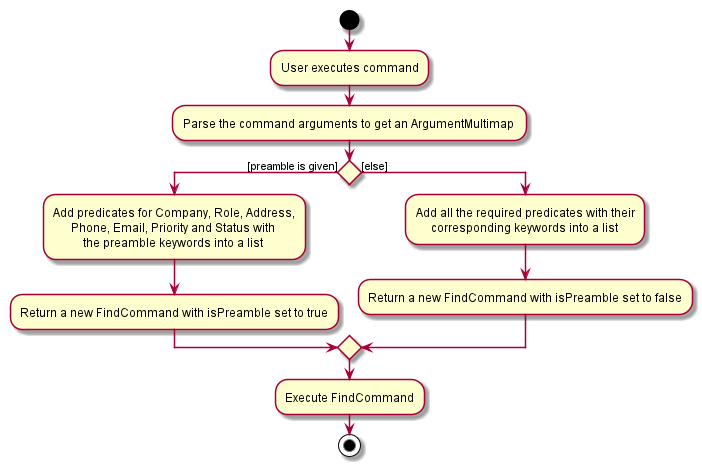
4.5.5. Design Considerations
4.5.5.1. Aspect: How to implement the different versions of Find command
-
Alternative 1 (current choice): Use a standardized command with the version to invoke determined by the type of user input parameters.
-
Pros: More streamlined, only one command.
This ensures that the user dont have to remember multiple command to use the different versions. -
Cons: Longer and less specific execute method.
-
-
Alternative 2: Use separate commands for the different versions of find.
-
Pros: More specific execute method for each of the command.
-
Cons: Makes the user remember more commands.
-
-
Alternative 3: Use the first word of the user input parameter to select which version of find command to invoke.
-
Pros: Slightly more streamlined than multiple commands.
This still requires user to remember the right words to invoke the different versions. -
Cons: Longer and less specific execution method.
-
4.6. Archival System
This feature allows users to store chosen internship application(s) into the archival.
The entire system is driven by two mechanisms:
-
the ability to switch views between the archived and unarchived list of internship application(s)
-
the ability to move internship application(s) into the archived list and vice-versa
The two mechanisms can be further broken down into the following four commands: list, archival, archive, and unarchive.
4.6.1. List & Archival
To handle the ability for a user to switch views, we implemented the commands list and archival:
-
listallows the user to view the unarchived internship application(s) -
archivalallows the user to view the archived internship application(s)
From here on, we will refer to the list of unarchived internship application(s) as the main list, and the list of archived internship application(s) as the archival list.
Beyond the primary purpose of allowing users to switch between their view of main and archived list of internship application(s),
list and archival also helps to verify that the archive and unarchive commands are used appropriately.
This means that a user should not archive an internship application when it is already in the archival — doing so will raise an exception.
This is identical for the unarchive command in the main list as well.
4.6.1.1. Implementation
The class diagram below depicts the important methods and attributes that provide us the ability to switch views between the main list and the archival list.
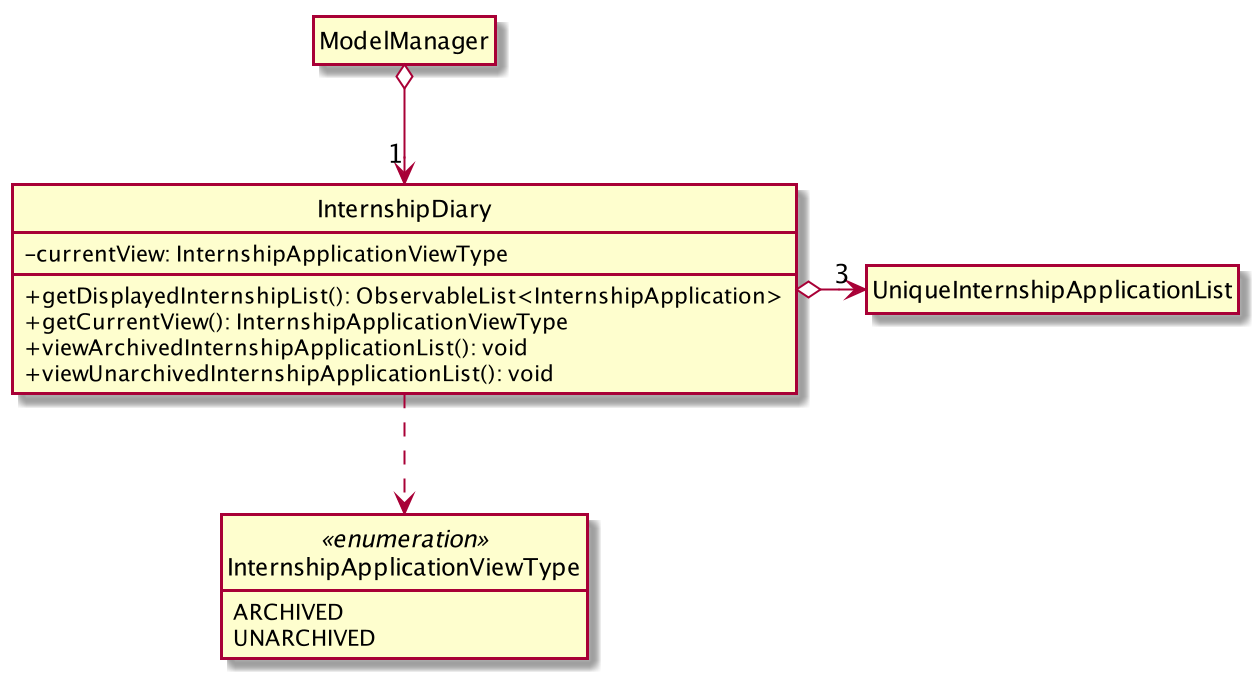
InternshipDiary that showcases the methods and attributes required for view-switchingThe object diagram below illustrates the three UniqueInternshipApplicationList objects maintained by InternshipDiary:
-
displayedInternships -
archivedInternships -
unarchivedInternships

UniqueInternshipApplicationList objects maintained by InternshipDiaryAs the name suggests, displayedInternships is the list that is shown to the user in the GUI. It references either
archivedInternships or unarchivedInternships at any one time.
When a user is viewing the main list, displayedInternships references unarchivedInternships.
And when a user is viewing the archival list, displayedInternships references archivedInternships.
The following sequence diagram illustrates how an archival command is executed.
The list command is similar to archival.
You may use the same sequence diagram for the list command.
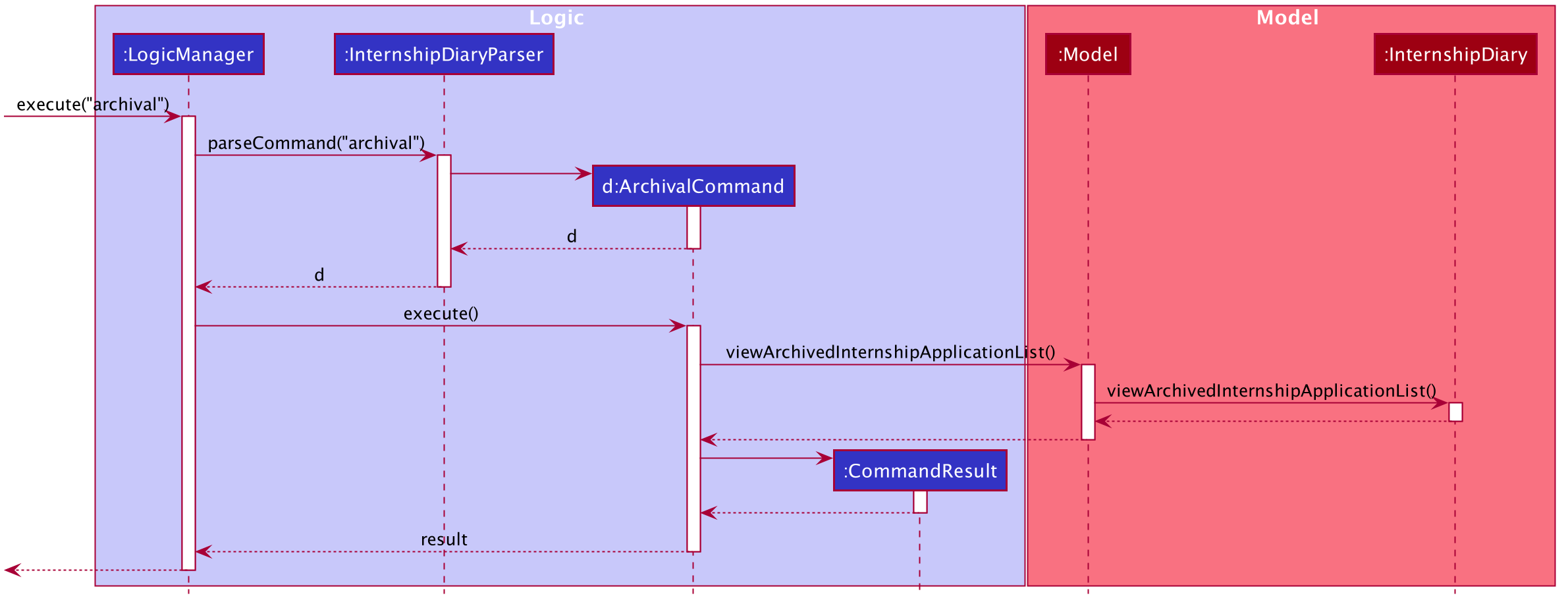
archival CommandThe following code snippet is retrieved from the InternshipDiary class.
It illustrates the internal workings of how we switch the view between the archived list and the main list.
public void viewArchivedInternshipApplicationList() {
this.displayedInternships = archivedInternships;
this.currentView = InternshipApplicationViewType.ARCHIVED;
firePropertyChange(DISPLAYED_INTERNSHIPS, getDisplayedInternshipList());
}
It can be seen explicitly from the code snippet that we make use of referencing to switch between the views of archival and main list.
However, such implementation brings about issues with reactivity — where elements that reference displayedInternships will not be aware of the reference change in displayedInternships whenever the user executes archival or list.
Therefore, in the above scenario, users would still see the main list after executing the archival command.
In order to resolve this issue, we need to employ the observer pattern design.
The broad idea is to assign each UI element to be an observer and InternshipDiary to be the observable.
Consequently, whenever there is a state change to InternshipDiary, the list of observers will be notified and updated automatically.
To achieve this observer pattern, we made use of the PropertyChangeSupport class and the PropertyChangeListener interface.
PropertyChangeSupport is a utility class to support the observer pattern by managing a list of listeners (observers) and firing PropertyChangeEvent to the listeners.
A class that contains an instance of PropertyChangeSupport is an observable.
On the other hand, a class that implements the PropertyChangeListener interface is an observer.
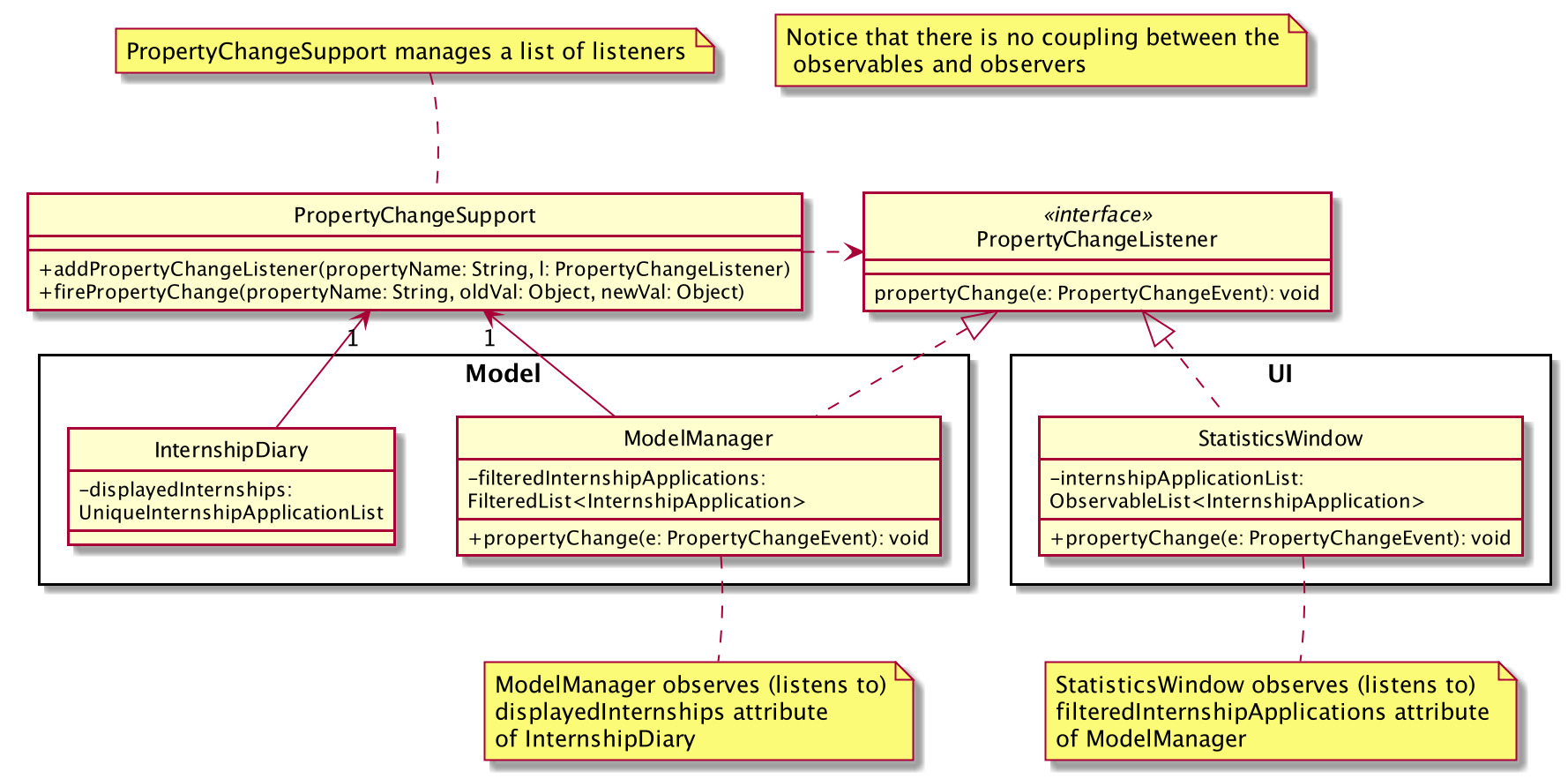
The class diagram above showcases our implementation of a two-tier observer-observable structure:
-
InternshipDiaryis an observable -
ModelManageris both an observable and observer-
It observes any changes to
displayedInternshipscontained inInternshipDiary
-
-
StatisticsWindowis an observer-
It observes any changes to
filteredInternshipApplicationscontained inModelManager
-
|
We will briefly discuss how the observer pattern works in our implementation.
Whenever an object wants to observe changes in another object, it will call the addPropertyChangeListener function of the PropertyChangeSupport instance from the appropriate object that it wishes to observe.
It will also have to specify which property of that object it wants to observe.
In our case, when ModelManager is created, it will call the addPropertyChangeListener function of the PropertyChangeSupport instance belonging to InternshipDiary.
The function call will look like this: addPropertyChangeListener("displayedInternships", this) where this
is a reference to ModelManager itself (so that it can be registered as a listener of the displayedInternships property of InternshipDiary).
The process is similar for any UI element that wants to observe the filteredInternshipApplications property of ModelManager.
As a result, whenever there is a change to the property displayedInternships in InternshipDiary, the PropertyChangeSupport instance of
InternshipDiary will call firePropertyChange to emit a PropertyChangeEvent to ModelManager.
The emitted event will trigger the propertyChange function of ModelManager.
ModelManager can then retrieve the new reference from the event and update its filteredInternshipApplications accordingly.
It will then repeat the event emission process to any UI element (e.g. StatisticsWindow) that is observing the
filteredInternshipApplications property.
The following activity diagram gives a high-level overview of the above event-driven process.
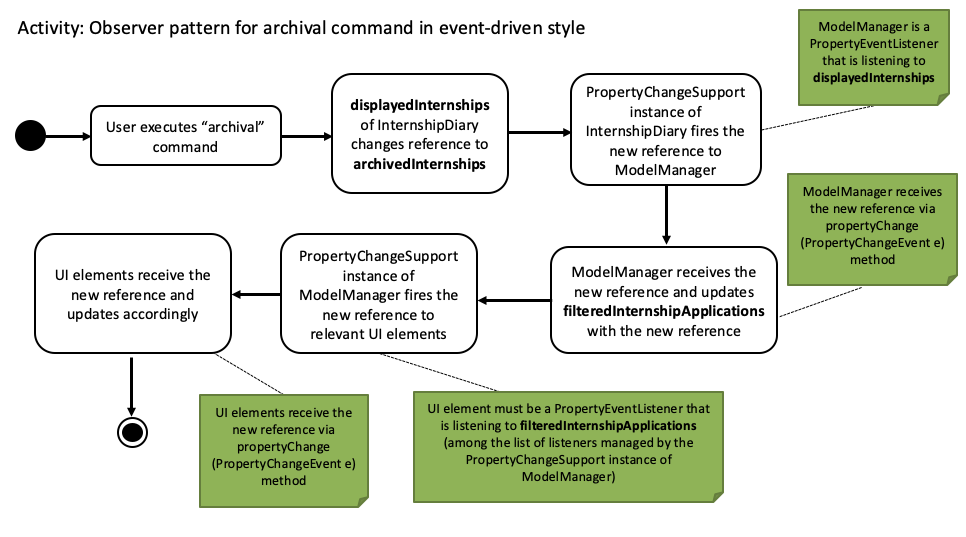
archival command
The two-tier observer-observable structure is necessary.
This is because list and archival only changes the reference of displayedInternships. |
When 'ModelManager' updates its property filteredInternshipApplications with the new reference, UI elements that reference filteredInternshipApplications
will not be aware of the reference update to filteredInternshipApplications.
Thus, ModelManager has to notify and update the UI elements as well.
As an extension, our team also implemented enumeration for each property that is being observed. This modification ensures type safety and a way for us to track what properties are observed. This is especially important when many properties are being observed.
Below is the updated class diagram with the implementation of ListenerPropertyType enumeration.
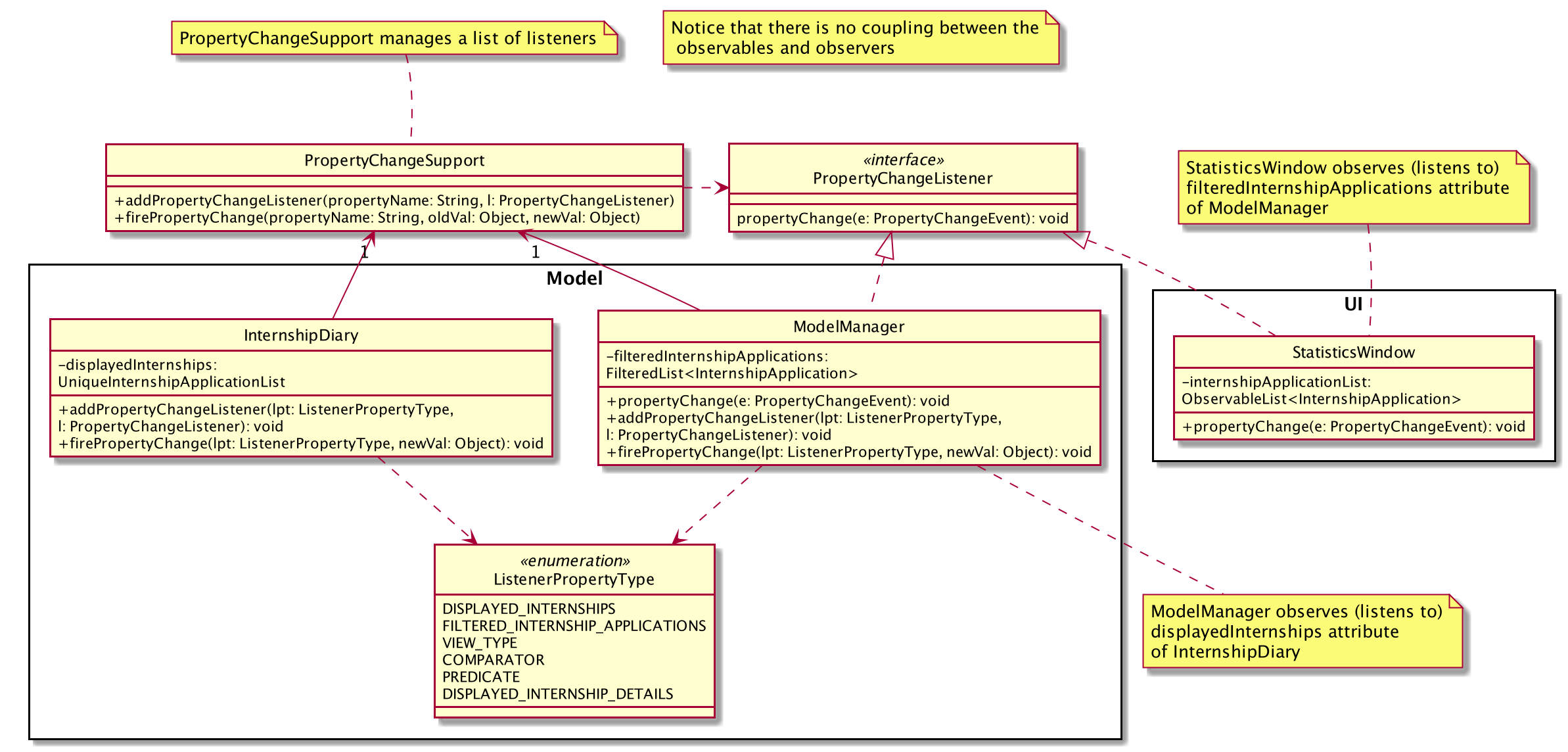
ListenerPropertyTypeAs seen from the diagram above, each observable will implement two additional methods to use ListenerPropertyType enumeration as parameters:
-
addPropertyChangeListener(ListenerPropertyType propertyType, PropertyChangeListener l) -
firePropertyChange(ListenerPropertyType propertyType, Object newValue)
This forms a layer of abstraction as we would not be allowed to call the addPropertyChangeListener and firePropertyChange methods of
PropertyChangeSupport directly.
4.6.1.2. Design Considerations
4.6.1.2.1. Aspect: How to implement the Archival View system on the backend
-
Alternative 1 (current choice): Maintain three
UniqueInternshipApplicationList:displayedInternships,unarchivedInternships, andarchivedInternships.displayedInternshipswill be used as the reference for other elements to retrieve the list of internship application(s) for usage. Whenever the user executesarchival, we will update the reference ofdisplayedInternshipstoarchivedInternshipsand vice-versa. In terms of storage, we will use only one list. This means that whenever we load the list of internship application(s) from the JSON save file, we will filter the internship application(s) appropriately intoarchivedInternshipsandunarchivedInternshipsinInternshipDiary. When saving, we will combine botharchivedInternshipsandunarchivedInternshipsinto a single list for storage.-
Pros: No need to modify the storage and its relevant test cases. This provides stability in the refactoring process.
-
Cons: Potentially expensive in terms of computation. Furthermore, we will have to implement observer pattern to handle the reference changes.
-
-
Alternative 2 (previous choice): Manipulate the current view of the internship application list by using Predicate and FilteredList, along with the boolean isArchived variable in
InternshipApplication. This will easily help us determine which internship application should be rendered.-
Pros: Very easy to implement and less expensive in terms of memory and computation. No need to implement observer pattern as there will be no reference updates.
-
Cons: Potentially unsustainable as conflicts are likely to arise with commands that make heavy use of predicates (e.g.
Findcommand).
-
4.6.1.2.2. Aspect: How to implement the Observer Pattern
-
Alternative 1 (current choice): Use
PropertyChangeSupportclass andPropertyChangeListenerinterface from thejava.beanspackage to support our implementation.-
Pros: Easy and intuitive to use. Good built-in support. Seems to be highly recommended by other users.
-
Cons: Seemingly negligible for our usage.
-
-
Alternative 2: Use Java’s
Observableclass andObserverinterface.-
Pros: Seemingly negligible for our usage.
-
Cons: The package is deprecated. Harder to understand and implement.
-
4.6.2. Archive & Unarchive
To allow users to move internship application(s) between the main and archival list of internship application(s), we implemented the commands archive and unarchive:
-
archiveallows a user to move internship application(s) from the main list to the archival list. -
unarchiveallows a user to move internship application(s) from the archival list to the main list.
The following activity diagram depicts the behaviour of an archive command.
You may use it as a reference for unarchive as well.
The activity diagrams for both are very similar.
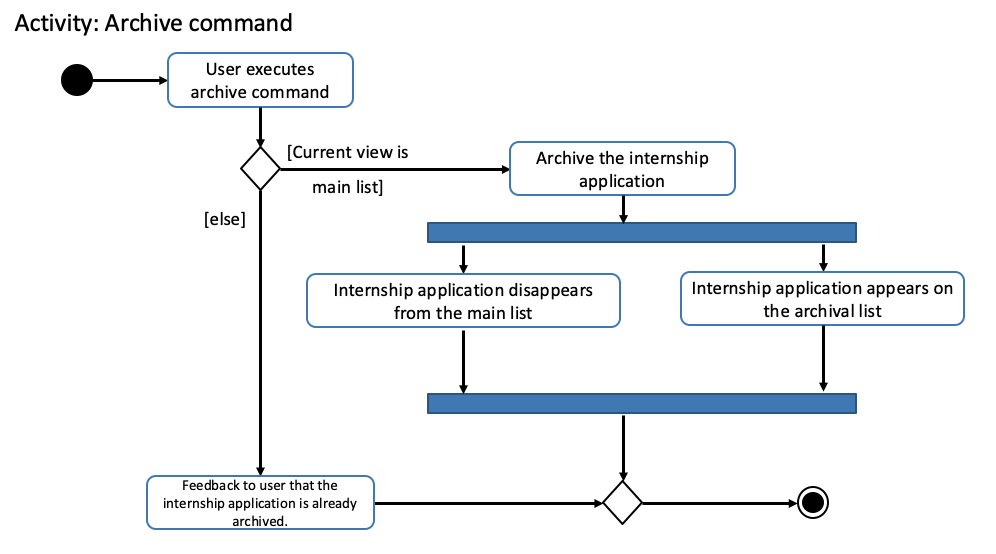
archive CommandWhile implementing the archive and unarchive commands, we realised that users may sometimes want to cherry-pick multiple internship application(s) to execute on or mass-execute on certain types of internship application(s).
For example, a user may want to archive all the internship application(s) that have the status of "rejected".
Commands like archive, unarchive, and delete can be seen as removal-based commands.
This is because the utility of such functions are very similar; in that they serve to modify the list by removing items.
Therefore, we specifically created a new class, RemovalBasedCommand, to extend the functionality of removal-based commands like archive, unarchive, and delete.
Through this new class, users will be able to execute the commands on multiple internship applications.
In the following section, we will delve slightly deeper and discuss about the lower-level implementation of the extended functionality.
4.6.2.1. Implementation
The following class diagram depicts our implementation of the extended functionality.
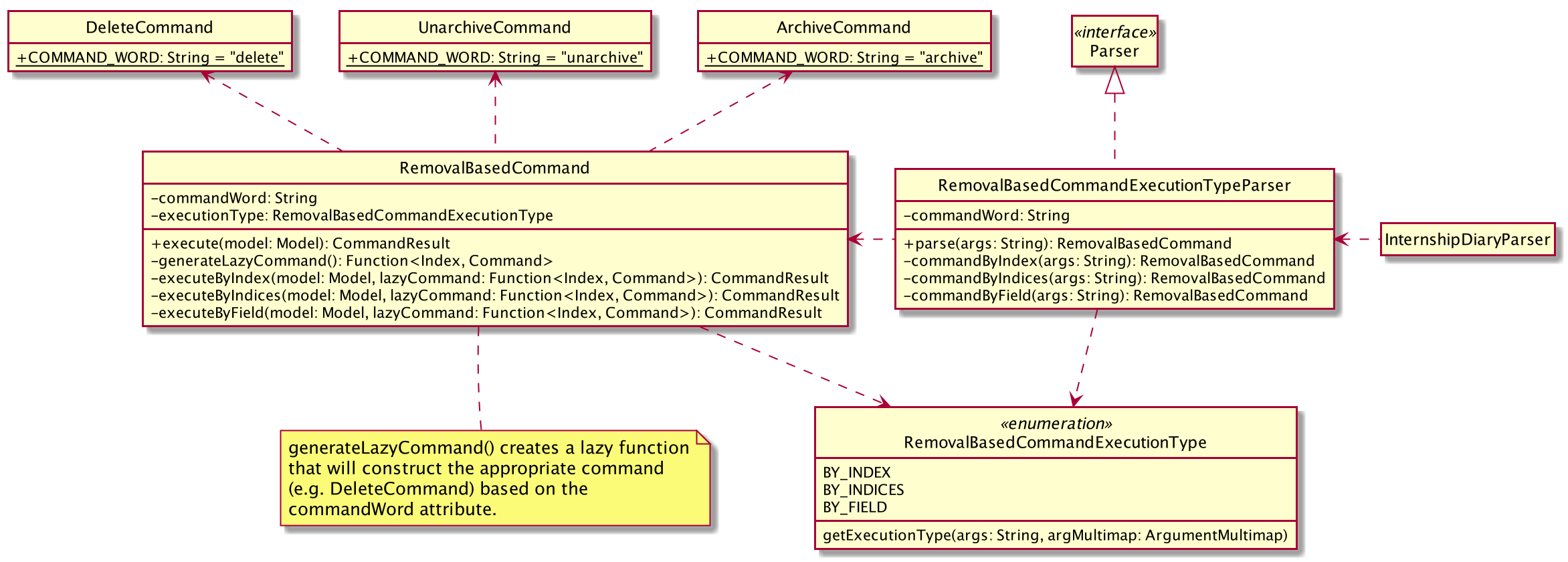
RemovalBasedCommand and RemovalBasedCommandExecutionTypeParser with its associated classesThe idea of the implementation can be summarized as follows:
-
The purpose of
RemovalBasedCommandExecutionTypeParseris solely to determine the execution type of the command by parsing the user input and callingRemovalBasedCommandExecutionType#getExecutionType. -
On the other hand,
RemovalBasedCommandis responsible for creating and executing the appropriate command based on thecommandWordthat was generated from the user input and passed down fromInternshipDiaryParser.
Users are able to execute removal-based commands like archive according to the execution types we have in the enumeration class RemovalBasedCommandExecutionType.
We have implemented the following execution types: BY_INDEX, BY_INDICES, and BY_FIELD.
For the execution type BY_FIELD, users can only execute by the Status field of an internship application currently.
The format of a removal-based command can take on any of the following forms:
-
commandINDEX -
commandINDEX, [INDEX], [INDEX], …
(where INDEX within the bracket is optional and there can only be as many INDEX as the number of internship application(s) displayed) -
commands/STATUS
(where STATUS refers to a valid internship application status)
Note that command can be any one of the removal-based commands.
It is important to note that each RemovalBasedCommandExecutionType works similarly.
At the core, all of them involves retrieving the index of an internship application to execute on.
The difference lies in the pre-processing stage — the steps an execution type takes to retrieve all the required indices.
Therefore, to ensure succinctness, we will only be illustrating the usage of the command archive with the execution type BY_FIELD.
Other variations of removal-based commands and execution types are similar.
The following sequence diagram provides a high-level overview of how the archive command with the execution type of BY_FIELD is executed in our application.
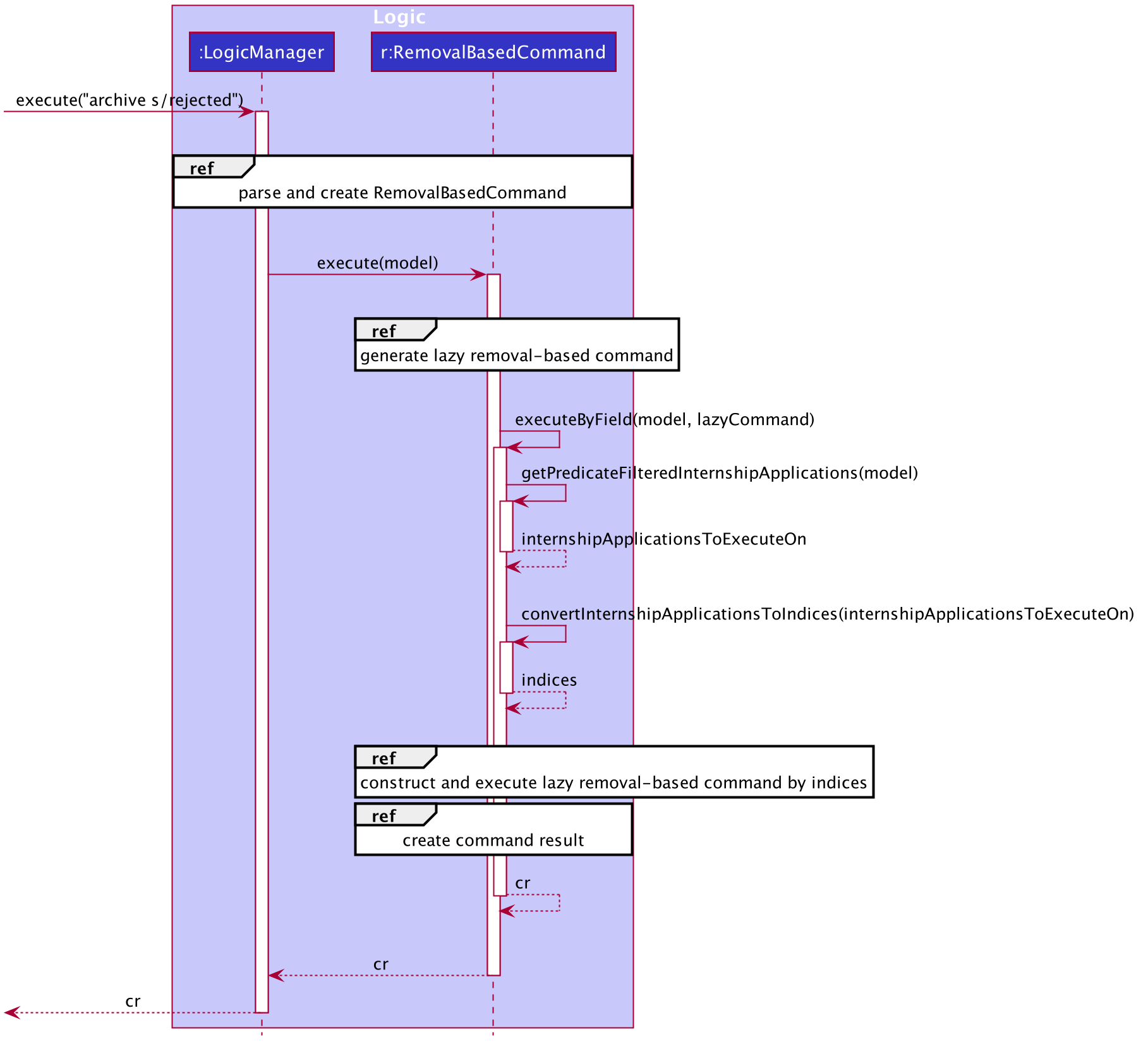
archive s/rejected commandAs illustrated in the diagram above, the pre-processing steps of BY_FIELD involves applying the appropriate predicate to filter the internship applications and then converting these internship applications to their respective index.
This provides us with required indices that we will execute the removal-based command archive on.
| We have implemented the mechanism to be reusable and extensible for new commands and execution types. |
This is evident in the sequence diagram above, where the different kinds of removal-based commands are abstracted from the diagram and referred to simply as RemovalBasedCommand.
This means that the above diagram is applicable to archive, unarchive, delete, and any other removal-based commands that we may wish to introduce in the future.
Furthermore, if we ever wish to create a new RemovalBasedCommandExecutionType (on top of BY_INDEX, BY_INDICES, and BY_FIELD), we may simply add a new alternative path to the diagram (or a new switch condition in terms of code).
The following sequence diagram captures how RemovalBasedCommandExecuteTypeParser parses the input and determines the execution type of the command.
It also shows how a RemovalBasedCommand is created with the appropriate RemovalBasedCommandExecutionType and command word.
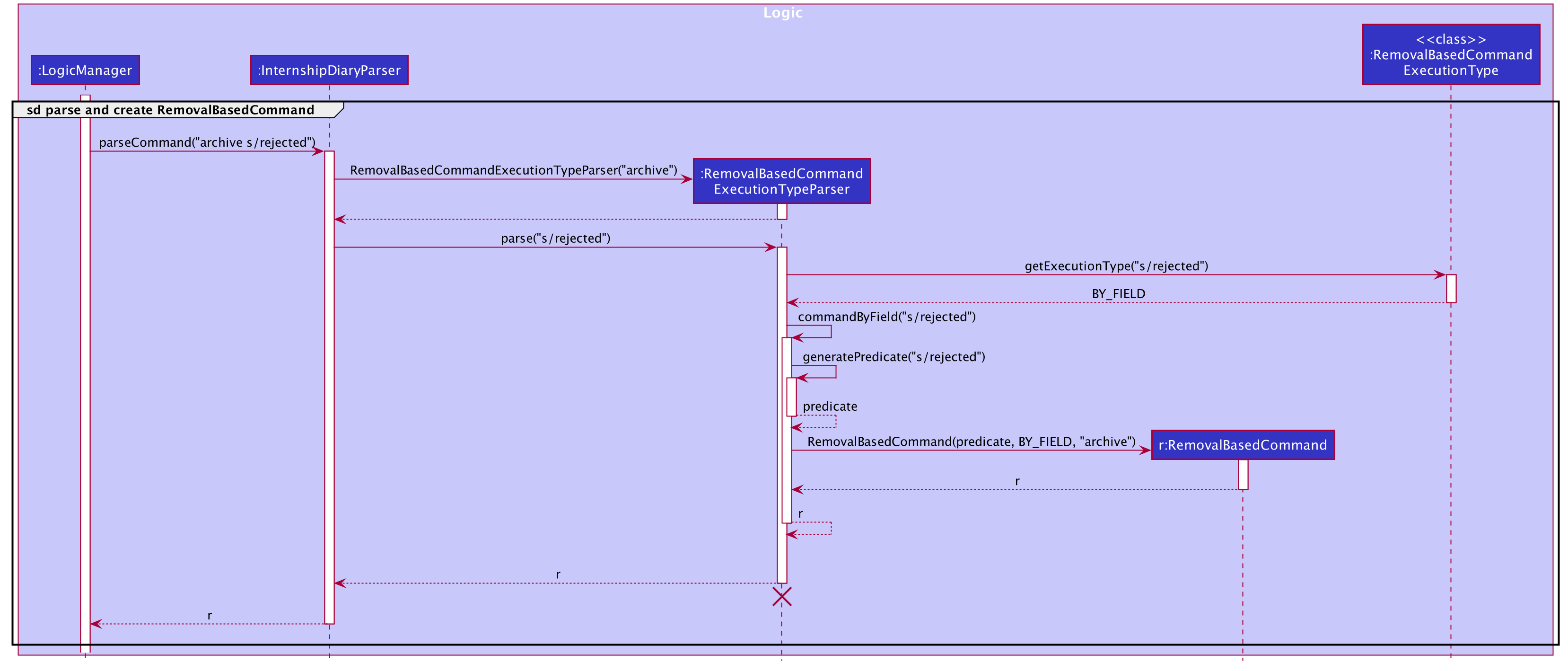
RemovalBasedCommandExecuteTypeParser parses input and determines the execution type of commandAs seen from the diagram above, the parser determined the execution type to be BY_FIELD and generated the appropriate predicate to construct a RemovalBasedCommand instance.
Based on the command word passed in to construct the RemovalBasedCommand instance, RemovalBasedCommand creates a lazy lambda function that can be called to construct the appropriate removal-based command for execution.
The following sequence diagram depicts the above behaviour.
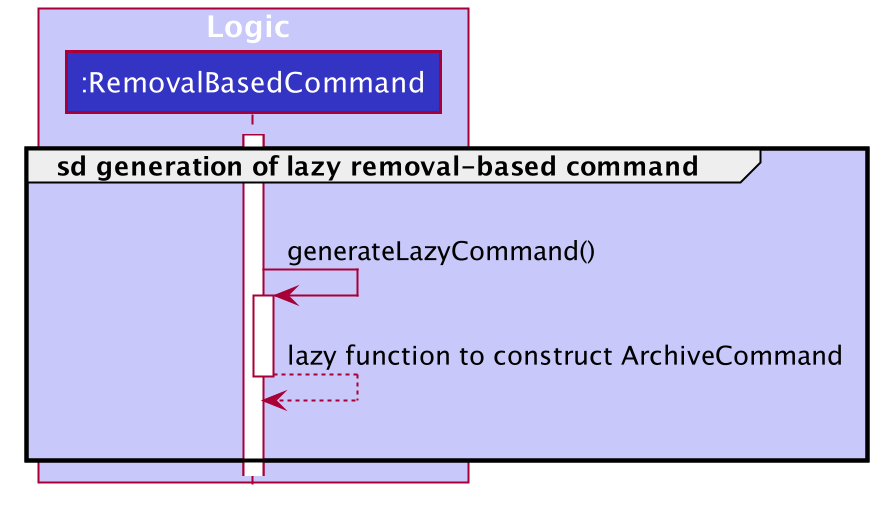
RemovalBasedCommand instanceAs the command word is archive, a lazy lambda function to construct an ArchiveCommand is returned.
The following sequence diagram captures the process of executing the lazy removal-based command on one index. This particular index allows us to retrieve the appropriate internship application.
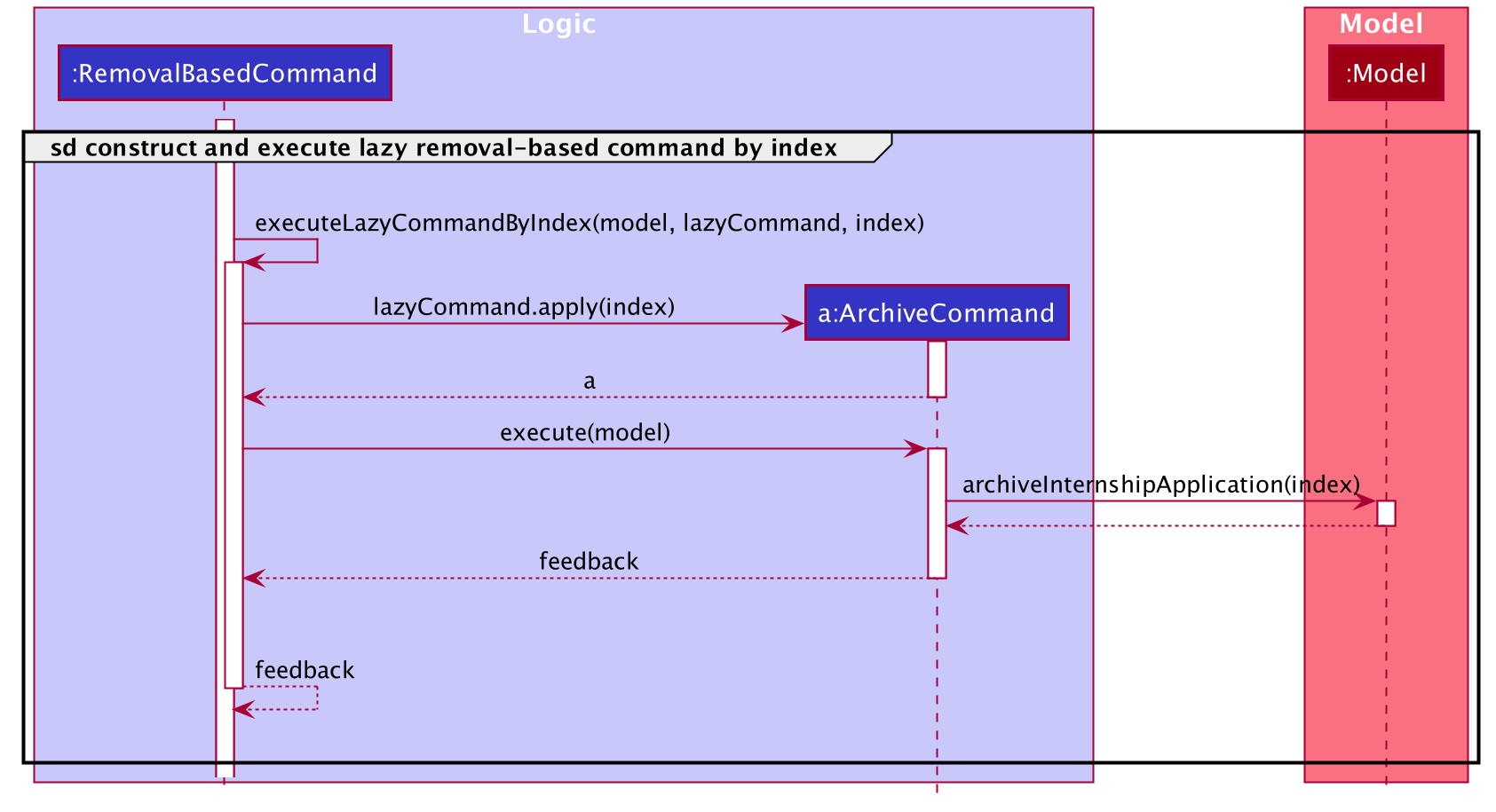
archive, on one indexIt can be seen that the previously-generated lazy command is executed in the above sequence diagram.
ArchiveCommand is constructed and subsequently executed on the index provided, by making the appropriate function call to the model to execute on the internship application.
In this case, archiveInternshipApplication is called.
The following sequence diagram captures the process of executing the lazy ArchiveCommand on indices.
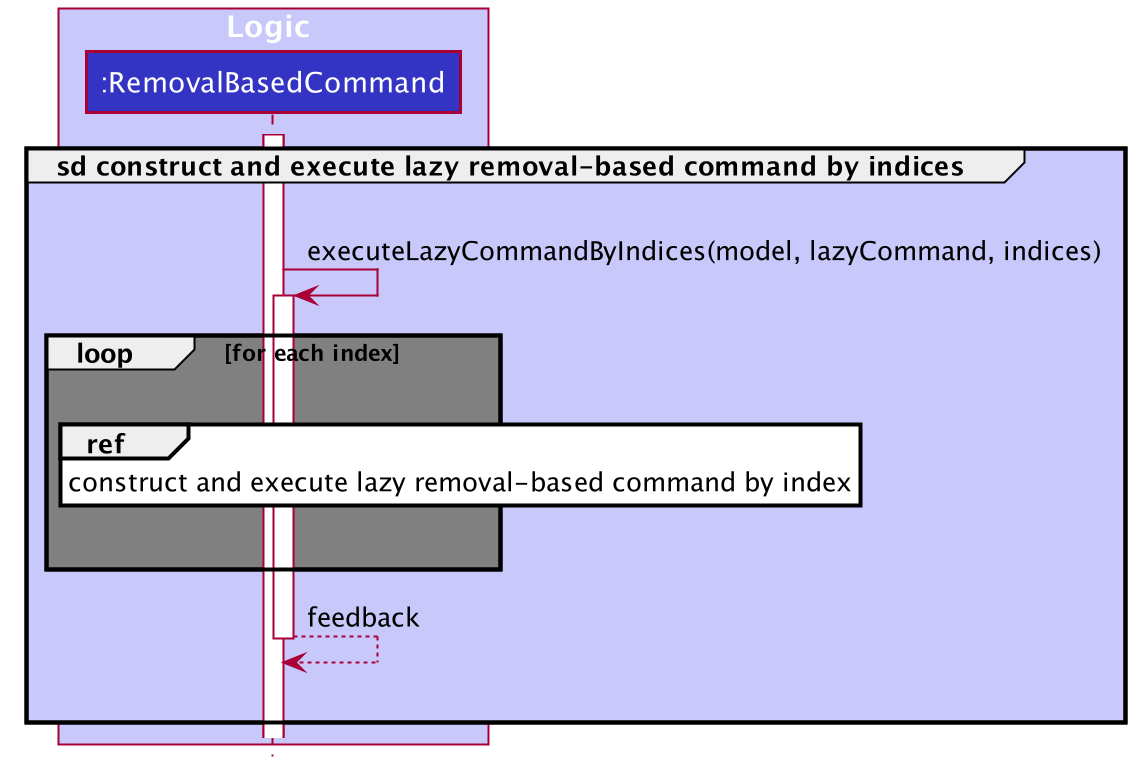
archive, on indicesAs seen above, executeLazyCommandOnIndices merely reuses the function executeLazyCommandOnIndex (from the previous sequence diagram) by running it on every index provided.
The feedback from each execution is cumulatively concatenated to form a single feedback.
The following sequence diagram captures the process of re-creating the command result in RemovalBasedCommand by using the feedback obtained from the specific command execution, which is ArchiveCommand in our example.
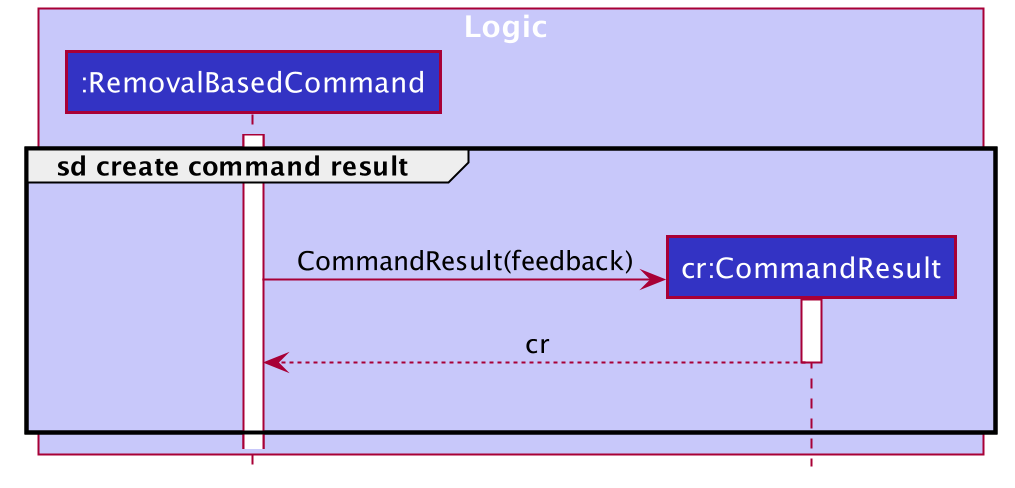
RemovalBasedCommand4.6.2.2. Design Considerations
4.6.2.2.1. Aspect: How to implement Multiple Execution Types for Removal-Based Commands
-
Alternative 1 (current choice): Use encapsulation to hold the appropriate command word, which will then be used to generate the removal-based command that will execute based on the execute type provided.
RemovalBasedCommandwill store the command word of the appropriate removal-based command and create the command whenRemovalBasedCommandis executed. This removal-based command will then be executed on the index/indices provided according to the execution type.-
Pros: Easier to implement and convey the idea to team members.
-
Cons: Will require multiple case handling (e.g. switch cases). Polymorphism may be a better solution in terms of code extensibility and elegance.
-
-
Alternative 2: Use polymorphism where each removal-based command extends the class
RemovalBasedCommandand inherit the appropriate execution type methods.-
Pros: Code will likely be more extensible and elegant.
-
Cons: Likely to require major redesigning and refactoring of existing logic codebase because we will have to modify
Commandclass. Furthermore, the changes may affect areas that we may not have considered. This is risky and will take a lot of time, effort, and team discussion.
-
4.7. Statistics Feature
This feature allows users to view relevant metrics about their internship application(s).
Currently, the tracked metrics include:
-
the amount of internship applications in each status
-
the percentage of internship applications in each status
4.7.1. Implementation
The following class diagram gives an overview of our implementation of the statistics feature.
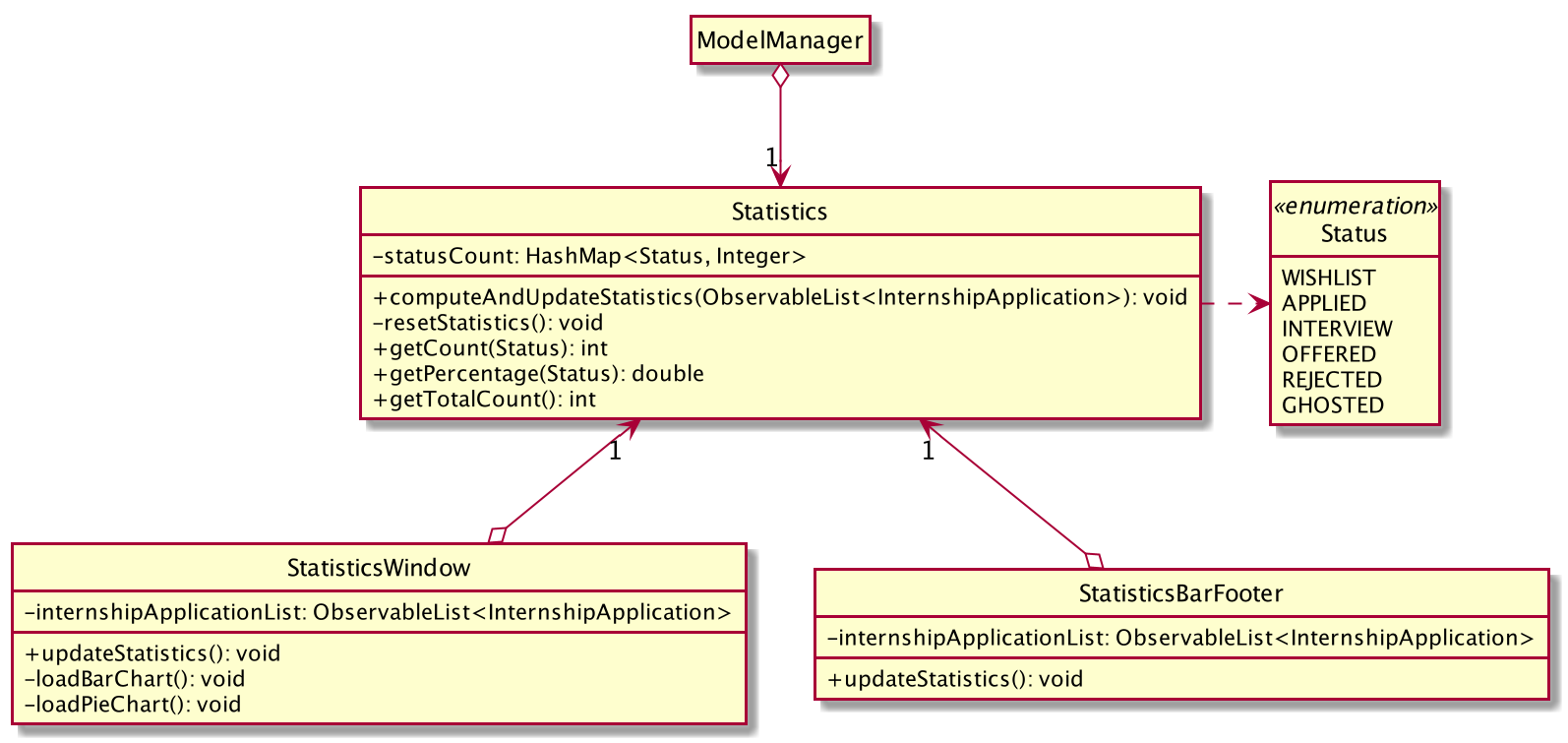
Statistics and its associated classesUsers will be able to view the metrics from two areas:
-
StatisticsBarFooter-
found at the bottom of the application in the form of a bar footer
-
serves as a quick view of the metrics in terms of counters
-
-
StatisticsWindow-
displayed on a separate window that is opened upon the command
stats -
serves as an additional graphical statistics interface for users to get a visual breakdown of the metrics
(currently in the form of a bar chart and a pie chart)
-
The Statistics object is used to generate statistics for any internship application list that it is given.
StatisticsWindow and StatisticsBarFooter each contains an instance of Statistics that helps them compute the relevant statistics whenever there is any update to the internship application list.
The internship application list can be updated either due to a change in reference in displayedInternships from InternshipDiary (e.g. archival and list) or any modifications to the current internship application list (e.g. add, delete, edit, archive, unarchive, find).
The following activity diagram illustrates how StatisticsWindow (StatisticsBarFooter shares the same workflow) is notified of the updates in the internship application list and how it subsequently updates the statistics.
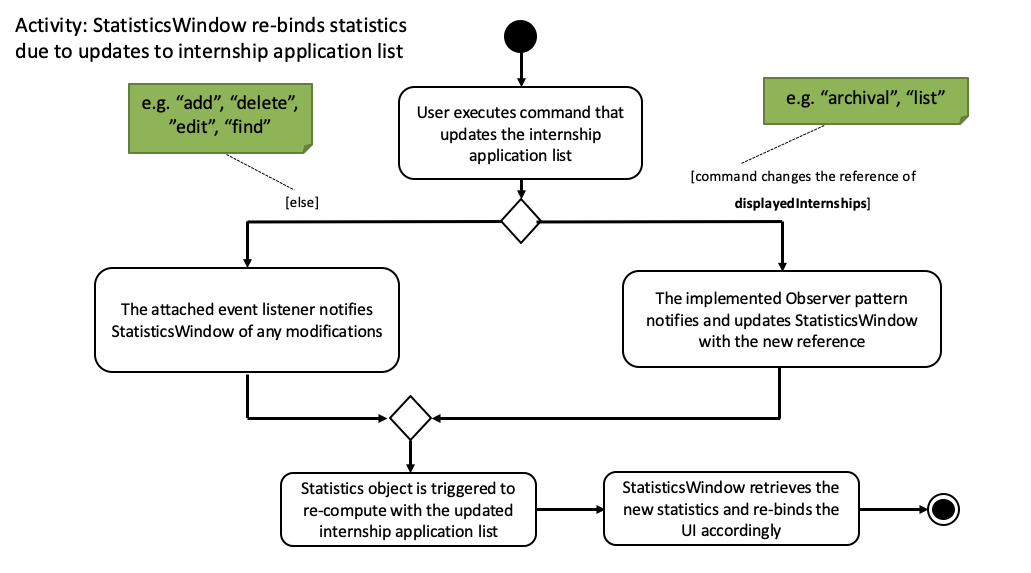
StatisticsWindow is notified of updates in the internship application list and how statistics is updated accordinglyUpon creation of the StatisticsWindow and StatisticsBarFooter, each of them will attach an event listener to the internship application list that it was given.
This event listener will notify them of any internal modifications to the internship application list.
On the other hand, both StatisticsWindow and StatisticsBarFooter will register themselves as observers as well.
This is so that the implemented observer pattern can notify them of any changes in the internship application list reference and update them with the new reference accordingly.
Any of the two updates above will trigger the Statistics to recompute with the updated internship application list.
StatisticsWindow and StatisticsBarFooter will then retrieve the required computed metrics from Statistics and re-bind the them to the UI accordingly.
4.7.2. Design Considerations
4.7.2.1. Aspect: Which list to retrieve data from to generate statistics
-
Alternative 1 (current choice): Use filtered ObservableList. The filtered list is dynamically updated by
findandsortcommand. The statistics model will generate statistics based on the dynamic filtering changes that occur in either the main list or archival list (the current view selected by user).-
Pros: Users will be able to choose which list they want to view the relevant statistics for. Works well with
archival,list, andfindcommands that dynamically changes the list. -
Cons: Often re-computation upon changes in the filtered list may cause some performance bottleneck.
-
-
Alternative 2: Use the base list that contains all of the internship application(s). The base list is not filtered according to predicate(s) set by users.
-
Pros: Require less re-computation compared to using filtered ObservableList, as it only re-computes upon addition(s), deletion(s), or changes in an internship application stored in the list.
-
Cons: May be unintuitive to some extent for users when the statistics do not tally with the current view of the list.
-
4.7.2.2. Aspect: How to store the statistics generated from data
A list of internship application(s) will be passed into the statistics model and upon function call, the statistics model will iterate through the list and generate/update the latest statistics accordingly.
-
Alternative 1 (current choice): Store the mapping between each status and count using a HashMap. The idea is to retrieve all the statuses available from the enum (whenever the statistics model is created) and create a HashMap with those status as the key and respective count as the value.
-
Pros: Extensible and reusable. Regardless of any changes, this system can dynamically handle the addition, deletion, or changes in statuses.
-
Cons: Seemingly negligible cons for our usage.
-
-
Alternative 2 (previous choice): Store each status count in separate variables that are initialized upon the creation of statistics model.
-
Pros: Straightforward and very easy to understand for future developers.
-
Cons: Very inextensible as we need to create new variables for new statuses each time.
-
4.8. Reminder Command
The reminder command displays to users a list of internship applications which:
-
have status
wishlistand need to be submitted in 7 days -
have status
interviewand interviews scheduled in 7 days
The applications will be displayed in order of earliest application date or scheduled interview date followed by those with later dates.
The following sequence diagram shows how the command is executed:
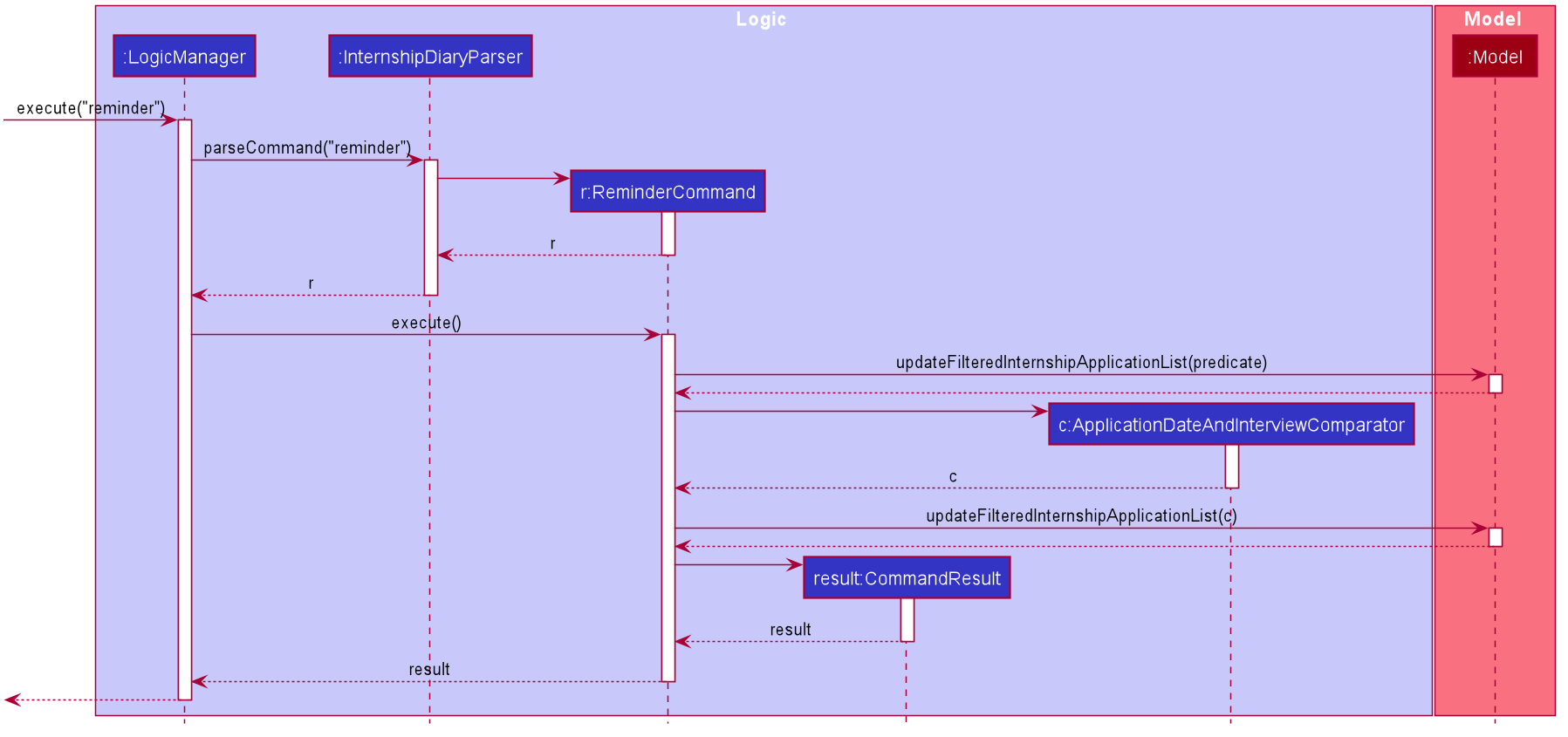
reminder Command4.8.1. Implementation
The reminder command is implemented in the class ReminderCommand.
When the execute() method of the ReminderCommand is called, several predicates classes implementing Predicate<InternshipApplication> are created:
-
ApplicationDateDuePredicate— Predicate to check whether theApplicationDatefield of an internship application has a date of the current date or within 7 days of the current date. -
StatusIsWishlistPredicate— Predicate to check whether theStatusfield of an internship application iswishlist. -
InterviewDateDuePredicate— Predicate to check whether there is at least one interview in theArrayList<Interview> interviewsof an internship application that has a date of the current date or within 7 days from the current date. -
StatusIsInterviewPredicate— Predicate to check whether theStatusfield of an internship application isinterview. -
IsNotArchivedPredicate— Predicate to check whether an internship application is not archived.
Firstly, an AND operation on the ApplicationDateDuePredicate and StatusIsWishlistPredicate as well as another
AND operation on the InterviewDateDuePredicate and StatusIsInterviewPredicate are performed. Next, an OR
operation is performed on the predicates from the previous two AND operations. An AND operation is then performed on
the predicate obtained from the previous OR operation and the IsNotArchivedPredicate. The IsNotArchivedPredicate
is used to make sure that archived internship applications do not appear when reminder is used. The final predicate
produced is then passed into the method updateFilteredInternshipApplicationList() of the ModelManager instance.
The activity diagram below summarises how each internship application is checked by the predicates mentioned above:
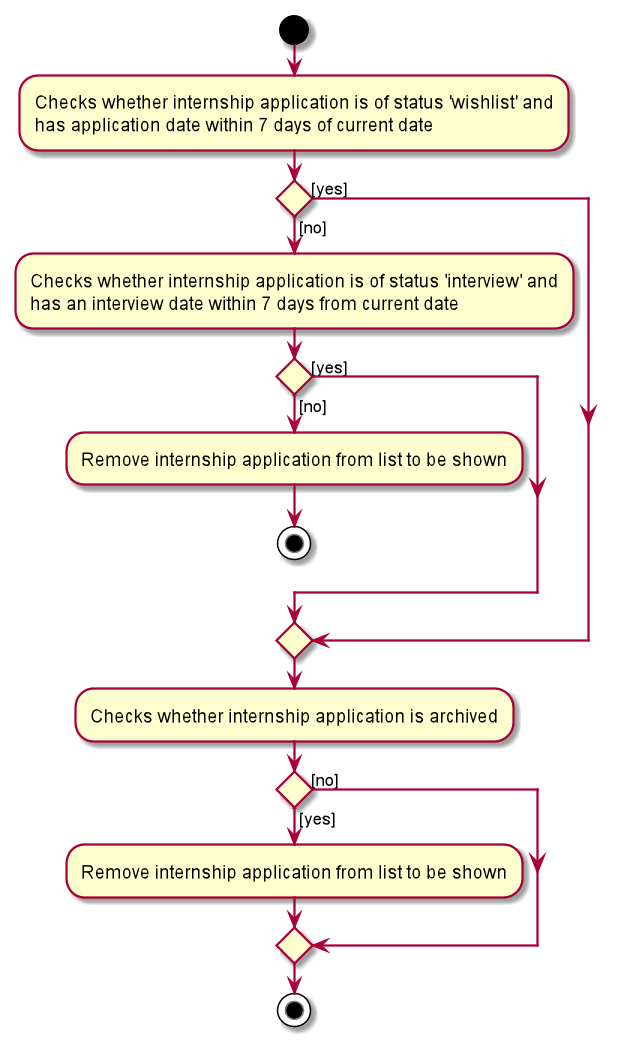
ReminderCommand filters out applications to displayA comparator ApplicationDateAndInterviewDateComparator implementing Comparator<InternshipApplication> is also created and
then passed into the method updateFilteredInternshipApplicationList() of the ModelManager instance to sort internship
applications in terms of which application is more urgent. For each internship application, its ApplicationDate field
as well as the earliest interview date in the List<Interview> interviews are compared to current date and the
earlier date out of the two is used for the sorting. The most urgent application will be at the top.
4.8.2. Design Considerations
4.8.2.1. Aspect: The order to display the internship applications
-
Alternative 1 (current choice): Display the internship applications in the order of either their
applicationDateorinterviewDateof the earliest interview scheduled inList<Interview> interviewsis closer to current date.-
Pros: More useful to the user as the user can directly know which internship application to focus on more, regardless of whether it is to prepare for the submission of the application, or to prepare for an interview scheduled.
-
Cons: Longer code as both the earliest
interviewDateand theapplicationDateof an application needs to be compared to current date to see which date is closer and that date will then be used to sort the internship applications.
-
-
Alternative 2: Display the internship applications in the order of which application’s
applicationDateis closer to current date.-
Pros: Cleaner code as the applications can just be sorted by their
applicationDate. -
Cons: Has the assumption that an internship application with a earlier
applicationDatewill have an interview scheduled at an earlierinterviewDateas compared to an application with laterapplicationDate. User might miss out on a earlierinterviewDatefor an application with laterapplicationDateand additional commands have to be typed in to checkinterviewDate.
-
4.8.2.2. Aspect: The filtering of internship applications to be shown
-
Alternative 1 (current choice): Using separate predicates(
ApplicationDateDuePredicate,StatusIsWishlistPredicate,InterviewDateDuePredicate,StatusIsInterviewPredicate) to filter out internship applications withApplicationDateor earliestinterviewDatewithin 7 days from current date.-
Pros: Cleaner code and each Predicate class only needs to check for one field. Easier to test as well.
-
Cons: Longer code as more predicates instantiated and used.
-
-
Alternative 2: Using just one predicate to filter out internship applications with
ApplicationDateor earliestinterviewDatewithin 7 days from current date.-
Pros: Reduce the number of predicates to be instantiated and to be used.
-
Cons: More conditions to check for in one predicate which could lead to potential bugs.
-
4.9. Logging
We are using java.util.logging package for logging.
The LogsCenter class is used to manage the logging levels and logging destinations.
-
The logging level can be controlled using the
logLevelsetting in the configuration file (See Section 4.10, “Configuration”) -
The
Loggerfor a class can be obtained usingLogsCenter.getLogger(Class)which will log messages according to the specified logging level -
Currently log messages are output through:
Consoleand to a.logfile.
Logging Levels
-
SEVERE: Critical problem detected which may possibly cause the termination of the application -
WARNING: Can continue, but with caution -
INFO: Information showing the noteworthy actions by the App -
FINE: Details that is not usually noteworthy but may be useful in debugging e.g. print the actual list instead of just its size
4.10. Configuration
Certain properties of the application can be controlled (e.g user prefs file location, logging level) through the configuration file (default: config.json).
5. Documentation
You may refer to the guide here.
6. Testing
You may refer to the guide here.
7. Dev Ops
You may refer to the guide here.
Appendix A: Product Scope
Target user profile:
-
is a Computer Science student
-
is actively looking for internships
-
has a need to organise and track internship applications
-
is a fast typist
-
is comfortable using CLI apps
-
prefers desktop applications
Value proposition: An easy-to-use CLI program that can help students to organise and track their internship applications
Appendix B: User Stories
Priorities: High (must have) - * * *, Medium (nice to have) - * *, Low (unlikely to have) - *
| Priority | As a … | I want to … | So that I can… |
|---|---|---|---|
|
user |
trace all my internship applications' contact |
easily follow up on the application |
|
user |
tag each application with a status |
track my internship application phase |
|
self-reflecting user |
mark what positions of internship I have been applying to |
look up past internship applications and see which positions I had been offered more as a reference for future applications |
|
user |
set reminders for internship application deadlines/interviews |
make sure I do not miss any internship opportunities by not applying in time / missing interviews |
|
user |
be able to add companies I wish to apply to in a wish-list |
apply to them when the window opens |
|
self-reflecting user |
see at which stage my internship application failed |
get a better idea of what to improve on |
|
future job seeker |
use this program to easily reference successful applications |
apply them to future endeavours |
|
disorganised user |
store my cover letters |
easily refer to them when applying for internships |
|
user |
give a rating to each internship based on my preference |
easily decide which internship to prioritise |
|
frequent interviewee |
maintain a checklist of questions to ask the interviewer |
|
|
first-time internship seeker |
use the program as a guide to internship applications |
learn how to start applying for an internship |
Appendix C: Use Cases
For all use cases below, the System is the Internship Diary (Internship Diary) and the Actor is the user, unless specified otherwise.
Furthermore, any references made to the list refers to the main list (unarchived internship applications), unless specified otherwise.
Use case: UC1 - View Main List
MSS
-
User requests to view the main list.
-
Internship Diary displays the main list.
Use case ends.
Use case: UC2 - View Archival List
MSS
-
User requests to view the archival list.
-
Internship Diary displays the archival list.
Use case ends.
Use case: UC3 - Add Internship Application
MSS
-
User requests to add an internship application to the list.
-
Internship Diary adds the internship application to the list.
Use case ends.
Extensions
-
1a. Internship Diary detects an error in the input.
-
1a1. Internship Diary shows an error message.
Use case resumes from step 1.
-
Use case: UC4 - Delete Internship Application
MSS
-
User requests to delete an internship application from the list.
-
Internship Diary deletes the internship application from the list.
Use case ends.
Extensions
-
1a. Internship Diary detects an invalid index.
-
1a1. Internship Diary shows an error message.
Use case resumes from step 1.
-
Use case: UC5 - Archive Internship Application
Precondition(s)
-
Internship Diary is displaying the main list.
Guarantee(s)
-
Internship Application appears in the archival list.
MSS
-
User requests to archive an internship application from the list.
-
Internship Diary archives the internship application.
Use case ends.
Extensions
-
1a. Internship Diary detects an invalid index.
-
1a1. Internship Diary shows an error message.
Use case resumes from step 1.
-
Use case: UC6 - Unarchive Internship Application
Precondition(s)
-
Internship Diary is displaying the archival list.
Guarantee(s)
-
Internship Application appears in the main list.
MSS
-
User requests to unarchive an internship application from the archival list.
-
Internship Diary unarchives the internship application.
Use case ends.
Extensions
-
1a. Internship Diary detects an invalid index.
-
1a1. Internship Diary shows an error message.
Use case resumes from step 1.
-
Use case: UC7 - Find Internship Applications
MSS
-
User views main list UC1.
-
User requests to find a list of Internship Application based on given keywords.
-
Internship Diary shows the list of Internship Application with any of the fields
Company,Role,Address,Phone,Email,PriorityorStatusmatching any of the keywords.Use case ends.
Extensions
-
1a. User views archival list UC2.
Use case resumes from step 2.
-
2a. No Internship Application is shown.
Use case ends.
Use case: UC8 - Find Internship Applications by Specific Field(s)
MSS
-
User views main list UC1.
-
User requests to find a list of Internship Application based on given keywords for specific field(s).
-
Internship Diary shows the list of Internship Application with the specified field(s) matching the any of the given keywords for each field.
Use case ends.
Extensions
-
1a. User views archival list UC2.
Use case resumes from step 2.
-
2a. Internship Diary detects an invalid date given for the
Datefield.-
2a1. Internship Diary shows an error message.
Use case resumes from step 2.
-
-
2b. No Internship Application is shown.
Use case ends.
Use case: UC9 - Edit Internship Application
MSS
-
User find Internship Applications UC7.
-
User requests to edit the fields of the Internship Application.
-
Internship Diary updates the new fields of the Internship Application.
Use case ends
Extensions
-
2a. The given index is invalid.
-
2a1. Internship Diary shows an error message
Use case resumes at step 1
-
Use case: UC10 - Prioritise Internship Application
MSS
-
User find Internship Applications UC7.
-
User requests to prioritise the Internship Application.
-
Internship Diary updates the priority level of the Internship Application.
Use case ends
Use case: UC11 - Sort Internship Application
MSS
-
User requests to sort the list.
-
Internship Diary sorts the list.
-
Internship Diary displays the sorted list.
-
Footer displays the field which list is sorted by.
Use case ends
Extensions
-
1a. Internship Diary detects the keyword reverse.
-
1a.1. Internship Diary sorts the list in reverse order.
Use case resumes from step 3.
-
-
1b. Internship Diary detects invalid syntax.
-
1b.1. Internship Diary shows an error message.
Use case ends
-
Use case: UC12 - Select Internship Application
MSS
-
User requests to select an Internship Application.
-
Internship Diary displays selected Internship Application.
Use case ends
Extensions
-
1a. The Internship Application to be selected does not exist.
-
1a.1. Internship Diary shows an error message.
Use case resumes at step 1
-
Use case: UC13 - Add Interview
MSS
-
User find Internship Applications UC7.
-
User requests to add an Interview to a specific Internship Application.
-
Internship Diary creates an Interview.
-
Internship Diary adds Interview into Internship Application.
Use case ends
Extensions
-
2a. The Internship Application does not exist.
-
2a.1. Internship Diary shows an error message.
Use case resumes at step 2
-
-
2b. The Interview to be created has invalid fields.
-
2b.1. Internship Diary shows an error message.
Use case resumes at step 2
-
-
3a. The Interview created already exists in the Internship Application.
-
3a.1 Internship Diary shows an error message.
Use case resumes at step 2
-
Use case: UC14 - Edit Interview
MSS
-
User requests to edit a specific Interview in a specific Internship Application.
-
Internship Diary creates a new Interview with edited fields.
-
Internship Diary replaces old Interview with new Interview in Internship Application.
Use case ends
Extensions
-
1a. The Internship Application does not exist.
-
1a.1. Internship Diary shows an error message.
Use case resumes at step 2
-
-
1b. The new Interview to be created has invalid fields.
-
1b.1. Internship Diary shows an error message.
Use case resumes at step 2
-
-
2a. The edited Interview already exists in the Internship Application.
-
2a.1 Internship Diary shows an error message.
Use case resumes at step 2
-
Use case: UC15 - Delete Interview
MSS
-
User requests to delete a specific Interview in a specific Internship Application.
-
Internship Diary removes Interview in Internship Application.
Use case ends
Extensions
-
1a. The Internship Application does not exist.
-
1a.1. Internship Diary shows an error message.
Use case resumes at step 2
-
-
1b. The Interview to be deleted does not exist.
-
1b.1. Internship Diary shows an error message.
Use case resumes at step 2
-
Use case: UC16 - View Statistics
Guarantee(s)
-
Separate window that contains the statistics appears.
MSS
-
User requests to view the statistics of his internship application(s).
-
Internship Diary displays the statistics.
Use case ends.
Use case: UC17 - Clear Command
MSS
-
User requests to delete all internship application(s).
-
Internship Diary prompts the user for confirmation.
-
User enters confirmation phrase.
-
Internship Diary deletes all internship application(s).
Use case ends.
Extensions
-
3a. The user enters something else.
-
3a.1. Internship Diary does not delete any internship application(s).
Use case ends.
-
Use case: UC18 - Getting Internship Application due or has interviews in 7 days in main list
MSS
-
User views main list UC1.
-
Users request to get applications which are due or have interviews in 7 days.
-
Internship Diary shows relevant applications.
Use case ends.
Extensions
-
2a. No Internship Application is shown.
Use case ends.
Use case: UC19 - Getting Internship Application due or has interviews in 7 days in archival list
MSS
-
User views archival list UC2.
-
Users request to get applications which are due or have interviews in 7 days.
-
No Internship Application is shown.
Use case ends.
Appendix D: Non Functional Requirements
Availability
-
The application is available for download on our GitHub release page in the form of a JAR file.
Capacity
-
The application should be able to store up to 1000 internship applications.
Performance
-
Response time to any user command is within 3 seconds.
-
The application should be able to contain and handle up to 300 internship applications before facing any form of performance bottleneck issues.
Reliability
-
The application should guide the user if it is unable to execute any of the user actions for various reasons.
Compatibility
-
The application should work as intended on any mainstream operating systems.
-
The application is guaranteed to work on Java version 11.
Usability
-
A user with above average typing speed for regular English text (i.e. not code, not system admin commands) should be able to accomplish most of the tasks faster using commands than using the mouse.
Robustness
-
The application should remain highly relevant to internship applications at any point in the future.
Integrity
-
There should be user updates to the internship applications to ensure its integrity.
-
When there is an application update, it should not compromise the integrity of the save file.
Maintainability
-
The application should be compliant with the coding standard set forth by CS2103T.
-
The application should be compliant with best coding practices highlighted in CS2103T.
-
The application should be designed such that any programmer with at least a year of experience should be able to read, maintain, and contribute to the source code easily.
Process
-
The project features are to be in line with any changes to real world internship application process.
Project Scope
-
The application requires manual addition of internship application into the system.
Privacy
-
The application should not store any information of user’s internship applications in remote storage.
Appendix E: Glossary
- Mainstream OS
-
Windows, Linux, Unix, OS-X
- Internship application
-
An application made by the user to a company offering an internship position
- Fields
-
A list of descriptions for an internship application grouped by type
- Window preferences
-
The last application window size and location the user used before shutdown
Appendix F: Product Survey
Below are some of the programs currently available that could be used to manage internship applications, as well as their pros and cons
Huntr
Pros:
-
Uses online database
-
Uses kanban board for drag and drop management
Cons:
-
Cannot use CLI for interactions with the system
-
Cannot use without internet connection
-
Cannot use without signing up for an account
-
Cannot get filtered list, the whole board is always shown and can be disorganised
-
Cannot directly get reminders for deadlines, must add a new task
Excel
Pros:
-
Free for NUS students
-
Allows the user to define what to include
-
Allows the user to use it offline
Cons:
-
Does not use CLI for interactions with the system
-
Cannot easily go straight to managing internship applications, steep learning curve
-
Can get messy quickly, no inbuilt filter and archive functions
-
Does not include inbuilt statistics and reminder functions
Appendix G: Instructions for Manual Testing
Given below are instructions to test the app manually.
| These instructions only provide a starting point for testers to work on; testers are expected to do more exploratory testing. |
G.1. Launch and Shutdown
-
Initial launch
-
Download the jar file and copy into an empty folder
-
Double-click the jar file
Expected: Shows the GUI with a set of sample internship applications. The window size may not be optimum.
-
-
Saving window preferences
-
Resize the window to an optimum size. Move the window to a different location. Close the window.
-
Re-launch the app by double-clicking the jar file.
Expected: The most recent window size and location is retained.
-
G.2. Using Internship Diary with Sample Internship Application List
-
Close Internship Diary.
-
Delete the file
./internshipdiary.json(if applicable). -
Launch Internship Diary.
Expected: A sample internship application list with 6 internship applications should be displayed.
G.3. Command Box
-
Retrieving previous commands
-
Prerequisites:
-
At least one command has been executed
-
Tester is not already at the oldest executed command
-
Test case: press up key
Expected: Previously executed command appears in the Command Box.
-
-
-
-
Retrieving later commands
-
Prerequisites:
-
Tester has retrieved at least one previous command
-
Test case: press down key
Expected: A command that was entered after the current retrieved command appears in the Command Box.
-
-
-
G.4. Main List View
-
Viewing the main list of internship application(s)
-
Test case:
list
Expected: All unarchived internship application(s) are displayed.
-
G.5. Archival List View
-
Viewing the archival list of internship application(s)
-
Test case:
archival
Expected: All archived internship application(s) are displayed.
-
G.6. Adding an Internship Application
-
Adding an internship application
-
Test case:
add c/Google r/Software Engineer d/17 04 2020 s/applied
Expected: New internship application is added to the bottom of the list. Details of the newly-added internship application shown in the feedback box. -
Test case:
add c/Google r/Software Engineer d/17 04 2020
Expected: Internship application is not added. Error details shown in feedback box.
-
G.7. Deleting Internship Application
-
Deleting an internship application by index
-
Prerequisites:
-
At least one internship application displayed
-
Test case:
delete 1
Expected: First internship application is deleted from the list. Details of the deleted internship application shown in the feedback box. -
Test case:
delete 0
Expected: No internship application is deleted. Error details shown in feedback box. -
Other incorrect delete commands to try:
delete,delete x(where x is larger than the list size)
Expected: Similar to previous.
-
-
-
-
Deleting internship applications by indices
-
Prerequisites:
-
At least two internship applications displayed
-
Test case:
delete 1, 2
Expected: First and second internship applications are deleted from the list. Details of the deleted internship applications shown in the feedback box. -
Test case:
delete 2, 1
Expected: First and second internship applications are deleted from the list. Details of the deleted internship applications shown in the feedback box. -
Test case:
delete 2, 2
Expected: Second internship application is deleted from the list. Details of the deleted internship application shown in the feedback box. -
Test case:
delete 0, 2
Expected: No internship application is deleted. Error details shown in feedback box.
-
-
-
-
Deleting internship application(s) by status field
-
Prerequisites:
-
at least one internship application with status "applied"
-
at least one internship application with status "wishlist"
-
no internship applications with status "rejected"
-
Test case:
delete s/applied
Expected: All internship applications with status "applied" are deleted from the list. Details of the deleted internship applications shown in the feedback box. -
Test case:
delete s/rejected
Expected: No internship applications deleted. Feedback box will show blank list of internship applications deleted. -
Test case:
delete s/notvalidstatus
Expected: No internship application deleted. Error details shown in feedback box. -
Test case:
delete s/applied wishlist
Expected: All internship applications with status "applied" or "wishlist" are deleted from the list. Details of the deleted internship applications shown in the feedback box. -
Test case:
delete s/applied notvalidstatus
Expected: All internship applications with status "applied" are deleted from the list. Details of the deleted internship applications shown in the feedback box.
-
-
-
G.8. Archiving Internship Application
-
Archiving an internship application by index
-
Prerequisites:
-
Current view is the main list
-
At least one internship application displayed
-
Test case:
archive 1
Expected: First internship application is archived from the list. Details of the archived internship application shown in the feedback box. -
Test case:
archive 0
Expected: No internship application is archived. Error details shown in feedback box. -
Other incorrect archive commands to try:
archive,archive x(where x is larger than the list size)
Expected: Similar to previous.
-
-
-
-
Archiving internship applications by indices
-
Prerequisites:
-
Current view is the main list
-
At least two internship applications displayed
-
Test case:
archive 1, 2
Expected: First and second internship applications are archived from the list. Details of the archived internship applications shown in the feedback box. -
Test case:
archive 2, 1
Expected: First and second internship applications are archived from the list. Details of the archived internship applications shown in the feedback box. -
Test case:
archive 2, 2
Expected: Second internship application is archived from the list. Details of the archived internship application shown in the feedback box. -
Test case:
archive 0, 2
Expected: No internship application is archived. Error details shown in feedback box.
-
-
-
-
Archiving internship application(s) by status field
-
Prerequisites:
-
current view is the main list
-
at least one internship application with status "applied"
-
at least one internship application with status "wishlist"
-
no internship applications with status "rejected"
-
Test case:
archive s/applied
Expected: All internship application(s) with status "applied" are archived from the list. Details of the archived internship applications shown in the feedback box. -
Test case:
archive s/rejected
Expected: No internship application(s) archived. Feedback box will show blank list of internship applications archived. -
Test case:
archive s/notvalidstatus
Expected: No internship application archived. Error details shown in feedback box. -
Test case:
archive s/applied wishlist
Expected: All internship applications with status "applied" or "wishlist" are archived from the list. Details of the archived internship applications shown in the feedback box. -
Test case:
archive s/applied notvalidstatus
Expected: All internship applications with status "applied" are archived from the list. Details of the archived internship applications shown in the feedback box.
-
-
-
G.9. Unarchiving Internship Application
-
Unarchiving an internship application by index
-
Prerequisites:
-
current view is the archival list
-
At least one internship application displayed
-
Test case:
unarchive 1
Expected: First internship application is unarchived from the list. Details of the unarchived internship application shown in the feedback box. -
Test case:
unarchive 0
Expected: No internship application is unarchived. Error details shown in feedback box. -
Other incorrect unarchive commands to try:
unarchive,unarchive x(where x is larger than the list size)
Expected: Similar to previous.
-
-
-
-
Unarchiving internship applications by indices
-
Prerequisites:
-
current view is the archival list
-
At least two internship applications displayed
-
Test case:
unarchive 1, 2
Expected: First and second internship applications are unarchived from the list. Details of the unarchived internship applications shown in the feedback box. -
Test case:
unarchive 2, 1
Expected: First and second internship applications are unarchived from the list. Details of the unarchived internship applications shown in the feedback box. -
Test case:
unarchive 2, 2
Expected: Second internship application is unarchived from the list. Details of the unarchived internship application shown in the feedback box. -
Test case:
unarchive 0, 2
Expected: No internship application is unarchived. Error details shown in feedback box.
-
-
-
-
Unarchiving internship application(s) by status field
-
Prerequisites:
-
current view is the archival list
-
at least one internship application with status "applied"
-
at least one internship application with status "wishlist"
-
no internship applications with status "rejected"
-
Test case:
unarchive s/applied
Expected: All internship application(s) with status "applied" are unarchived from the list. Details of the unarchived internship applications shown in the feedback box. -
Test case:
unarchive s/rejected
Expected: No internship application(s) unarchived. Feedback box will show blank list of internship applications unarchived. -
Test case:
unarchive s/notvalidstatus
Expected: No internship application unarchived. Error details shown in feedback box. -
Test case:
unarchive s/applied wishlist
Expected: All internship applications with status "applied" or "wishlist" are unarchived from the list. Details of the unarchived internship applications shown in the feedback box. -
Test case:
unarchive s/applied notvalidstatus
Expected: All internship applications with status "applied" are unarchived from the list. Details of the unarchived internship applications shown in the feedback box.
-
-
-
G.10. Adding an Interview to an Internship Application
-
Adding an interview while an internship application is displayed.
-
Prerequisites: List all internship applications using the
list.
Select the first internship application using theselect 1command. -
Test case:
interview 1 add o/true d/(internship application date)
As the interview relies on the date of application, use the application date in the internship application displayed.
Expected: Online interview added to the internship application. Details of the interview displayed in the list inside the displayed internship application. -
Test case:
interview 1 add o/false d/(internship application date) a/123 Kent Ridge Road
Expected: Offline interview added to the internship application. Details of the interview displayed in the list inside the displayed internship application. -
Test case:
interview 1 add o/true d/(internship application date - 1 )
Expected: No interview is added. Error details shown in the result box. -
Other incorrect interview add commands to try:
interview 1 add,interview 0 add,interview 1 add o/false d/(valid date)(offline interview must have address).
-
G.11. Editing an Interview in an Internship Application
-
Editing an interview while an internship application is displayed.
-
Prerequisites: List all internship applications using the
list.
Select the first internship application using theselect 1command.
Add an online interview to the first internship application using theinterview 1 add o/true d/(internship application date)command.
Let x be the index number of the new online interview as displayed inside the internship application displayed. -
Test case:
interview 1 edit x d/(internship application date + 1)Expected: The online interview’s date has been successfully changed. -
Test case:
interview 1 edit x o/false a/123 Kent Ridge Road
Expected: The online interview has been edited into an offline interview. -
Test case:
interview 1 edit x o/false
Expected: No change to online interview. Error details shown in the result box as address field is mandatory when editing an online into an offline interview. -
Test case:
interview 1 edit 0 o/false a/123 Kent Ridge Road
Expected: No change to online interview. Error details shown in the result box as interview index is out of bounds. -
Other incorrect interview edit commands to try:
interview 1 edit,interview 1 edit x(no change of interview fields will result in error).
-
G.12. Showing Statistics Window
-
Display statistics window
-
Test case:
stats-
Expected: A separate window will appear with graphical representation of the statistics.
-
-
G.13. Sorting the List of Internship Applications
-
Sorting a list of internship applications.
-
Prerequisites: List all internship applications using
list.
Select any internship application by clicking one.-
Test case:
sort c/Expected: No change in displayed internship details. Internship application list sorted by company (case insensitive). Sort order displayed in footer. -
Test case:
sort reverse c/
Expected: No change in displayed internship details. Internship application list sorted by company in reverse alphabetical order (case insensitive). Sort order displayed in footer. -
Test case:
sort reversed c/
Expected: Internship application list not sorted. Error details shown in the result box as invalid command format. No change in footer display. -
Test case:
sort c/ a
Expected: Internship application list not sorted. Error details shown in the result box as invalid command format. No change in footer display. -
Test case:
sort c/ r/
Expected: Internship application list not sorted. Error details shown in the result box as invalid command format. No change in footer display.
-
-
Prerequisites: Use
findcommand to reduce size of internship application list without deleting any internship applications.
For example,find r/software-
Test case:
sort c/
Expected: No change to number of internship applications displayed.
-
-
Prerequisites: Ensure current internship application list has multiple internship applications with fields of the same value. For example, multiple internship applications with
rolebeingsoftware developer-
Test case:
sort r/
Expected: No change in order of internship applications with identical roles (stable sort).
-
-
-
Sorting a list of internship applications in
archivalmode.-
Repeat the above steps, but list all internship applications using
archival.
-
G.14. Getting Reminders for Internship Applications
-
Getting reminders for internship applications which are due or have interviews scheduled in 7 days
Test case:reminder
Expected: Only applications which are due or have interviews scheduled in 7 days will be shown. They should be displayed in order of earliest application date or scheduled interview date followed by those with later dates. -
Getting reminders for internship applications which are due or have interviews scheduled in 7 days in
archivalmode
Test case:reminder
Expected: No applications should be shown.
G.15. Finding Internship Applications
-
Finding a list of internship application.
-
Prerequisites: Starting from an empty list,
add 3 internship applications into the list using the following commands:
add c/Google r/Software Engineer a/123 Kent Ridge Road p/98765432 e/hr@google.com d/02-12-2019 w/10 s/applied
add c/Facebook r/Software Developer a/Singapore p/87654321 e/joinus@facebook.com d/20-04-2020 w/9 s/wishlist
add c/Shopee r/Product Developer a/5 Science Park Dr p/99999999 e/shopee@google.com d/10-03-2020 w/1 s/rejected -
Test case:
find
Expected: No change in list. Error details shown in the result box as at least one of the optional parameters must be entered. -
Test case:
find google
Expected: Only the internship applications with company namesGoogleandShopeewill be listed (google can be found in the email of Shopee) -
Test case:
find r/software developer
Expected: All 3 internship applications are listed. -
Test case:
find 02-12-2019
Expected: No internship applications are listed as general find don’t work with dates. -
Test case:
find d/02-12-2019
Expected: Only the internship applications with company namesGoogleis listed as it matches the application date. -
Test case:
find w/1
Expected: Only the internship applications with company namesShopeewill be listed (search for priority is not based on substring soGoogleis not listed)
-
G.16. Saving Data
-
Dealing with missing/corrupted data files
-
Internship Diary will load with an empty JSON file which will overwrite the existing corrupted data file upon the execution of any commands.
-
Appendix H: Effort
A lot of time and effort were channeled into designing and implementing a set of robust, easy-to-use, and cohesive features for our users.
To help users organise their internship applications, we designed and implemented find, sort, archive and unarchive. On the other hand, to help users track
their internship applications, we designed and implemented reminder, interview, and stats.
H.1. Challenges Faced
H.1.1. Designing Find, Sort, and Reminder
There was a need to plan how find, sort, and reminder should behave and how we can extend such commands with new behaviours easily in the future.
This required a lot of team discussion and effort in terms of coming up with drafts for our intended implementation. For find, we had to ensure that
when a new field is added, or if an existing field is changed, we can simply add / edit predicate classes accordingly and make changes only in the FindCommandParser.
For sort, we had to ensure that adding or removing a sort comparator only required very minimal changes to the SortCommandParser (which requires only a single line in our final implementation).
On top of that, we also had to ensure that it is easy to pass a description of the predicate and comparator used to the PredicateDisplayFooter and SortDisplayFooter respectively.
For reminder, there was a need to plan the conditions to decide which internship applications to show when the reminder command is used for the implementation of the corresponding predicates to use.
H.1.2. Implementing Interview Classes and Commands
The interview classes must be highly extensible as new interview types could be added in the future. Therefore, extra effort was made to ensure new interviews could be easily integrated into the current logic and model structure of interviews.
H.1.3. Enabling Multiple Execution Type Functionality for Removal-Based Commands
We wanted to make the application as user-friendly as possible for the users. Being able to execute removal-based commands like delete, archive, and unarchive is therefore a good feature to include.
However, there are many ways to extend our commands to accommodate multiple execution type. The only question is: at what cost? As a team, we had to conduct multiple online team meetings during milestone v1.4
to discuss about the most suitable, time-effective, and extensible implementation considering that the deadline is around the corner.
H.1.4. Modifying GUI
The GUI must be made easily readable and understandable by the user. Research and effort was made to ensure a well organised and consistent application layout.
H.1.5. Integrating the Implemented Features
Due to the cohesive nature of our features, it resulted in extensive interaction between the components — ensuring a smooth integration was therefore a significant challenge. For example, as our features introduced many new UI elements and backend implementation, we ran into UI / data reactivity issue where ObservableList was no longer an adequate and sustainable solution.
We needed a more robust solution to help us keep the UI in sync with the state of our data. This required the team to look into how we can implement the observer pattern design into our system and the best options we have to implement the structure. There were various constraints that we had to be mindful of as we incorporated the observer pattern, mainly due to the way we implemented certain features (as reactivity issue was something we did not foresee). As this was our first time dealing with the observer pattern, we had to spend a good amount of time to research, understand, and implement it properly.